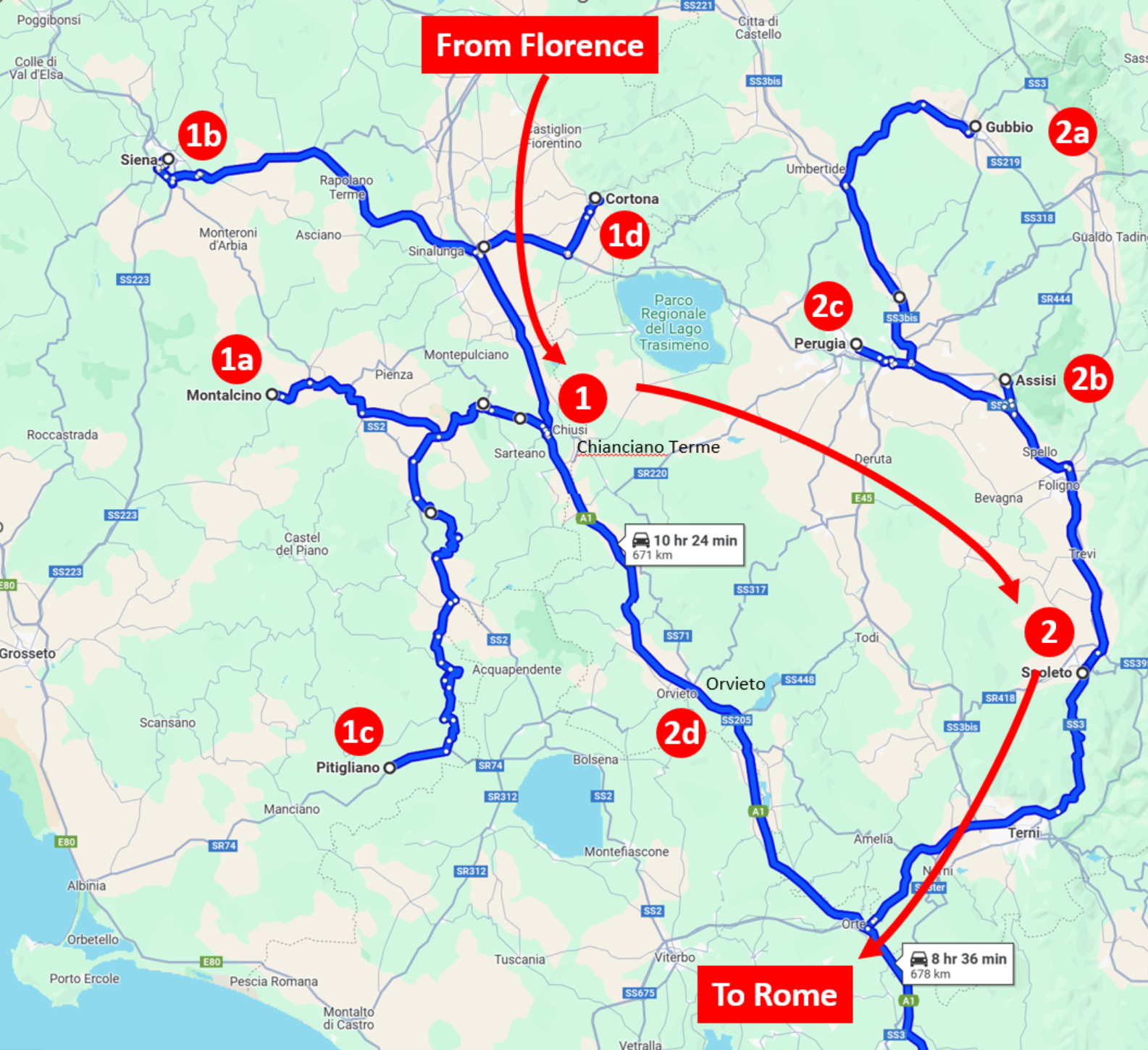
"Medieval Villages of Tuscany and Umbria", Road Scholars small group tour
After flying into Florence, we split the days between two hotels, Chianciano Terme (1) and Spoleto (2). From each hotel, we went on four day trips to nearby villages (a-d). The last day, after the last village, we went to Rome and spent the last night in a hotel near the airport. The travel times are the total time in buses between the four day trips.

Ginger knows that when the suitcases come out, we are leaving for a long time. Her plan to hide among the clothes, hoping we would pack her along, did not work out.
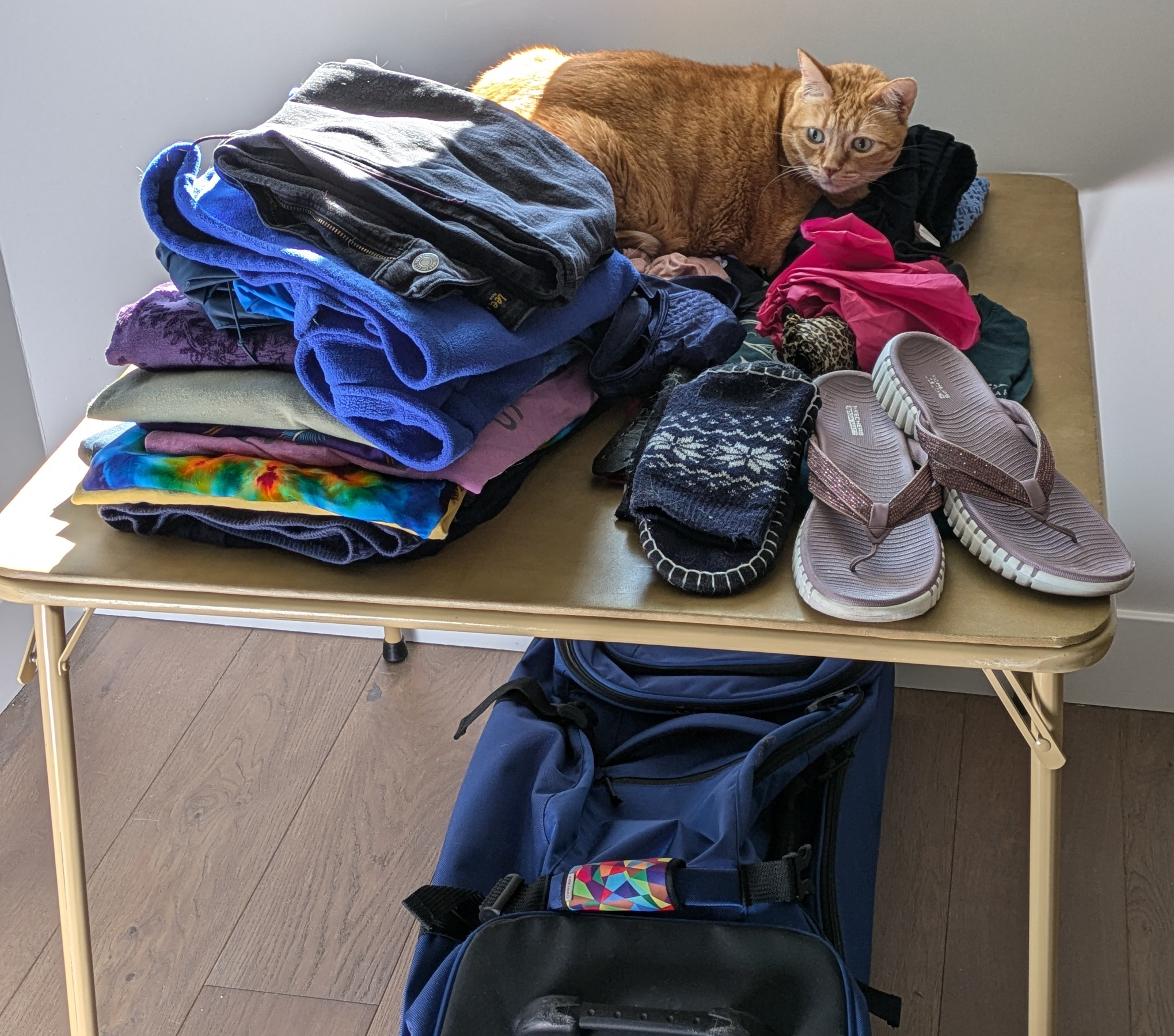
The bus we used was a little smaller than a full Greyhound bus, so it could maneuver through the small village streets more easily. Still, we usually had to get off the bus outside the village center and walk from there.
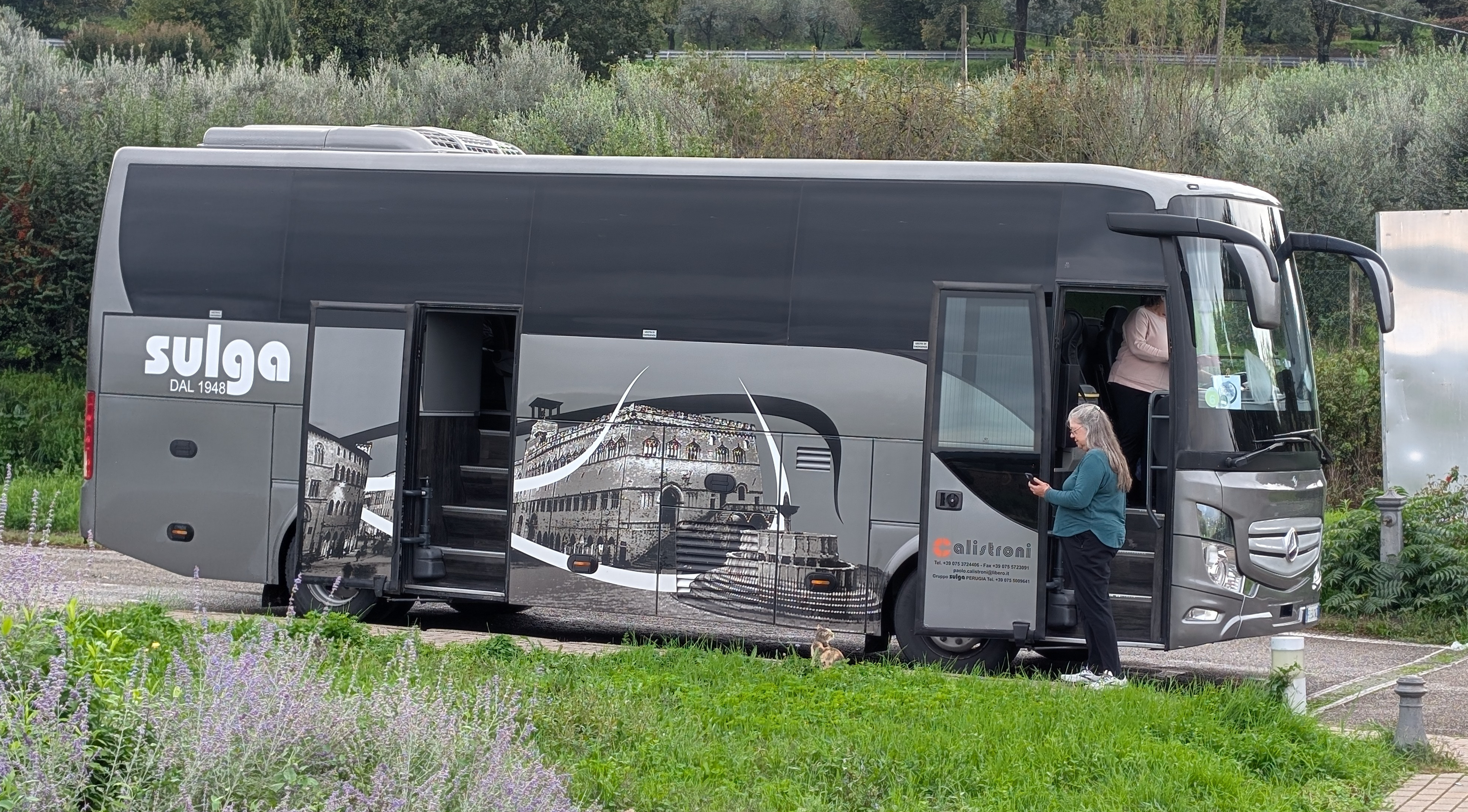
Our guide for the tour was Simona. Here, she is one of the box seats of a restored theatre telling us about the ceiling decoration. She has been a guide for most of her life; she majored in Japanese in college and spent the first half of her career guiding Japanese tourists before switching to English language tours.
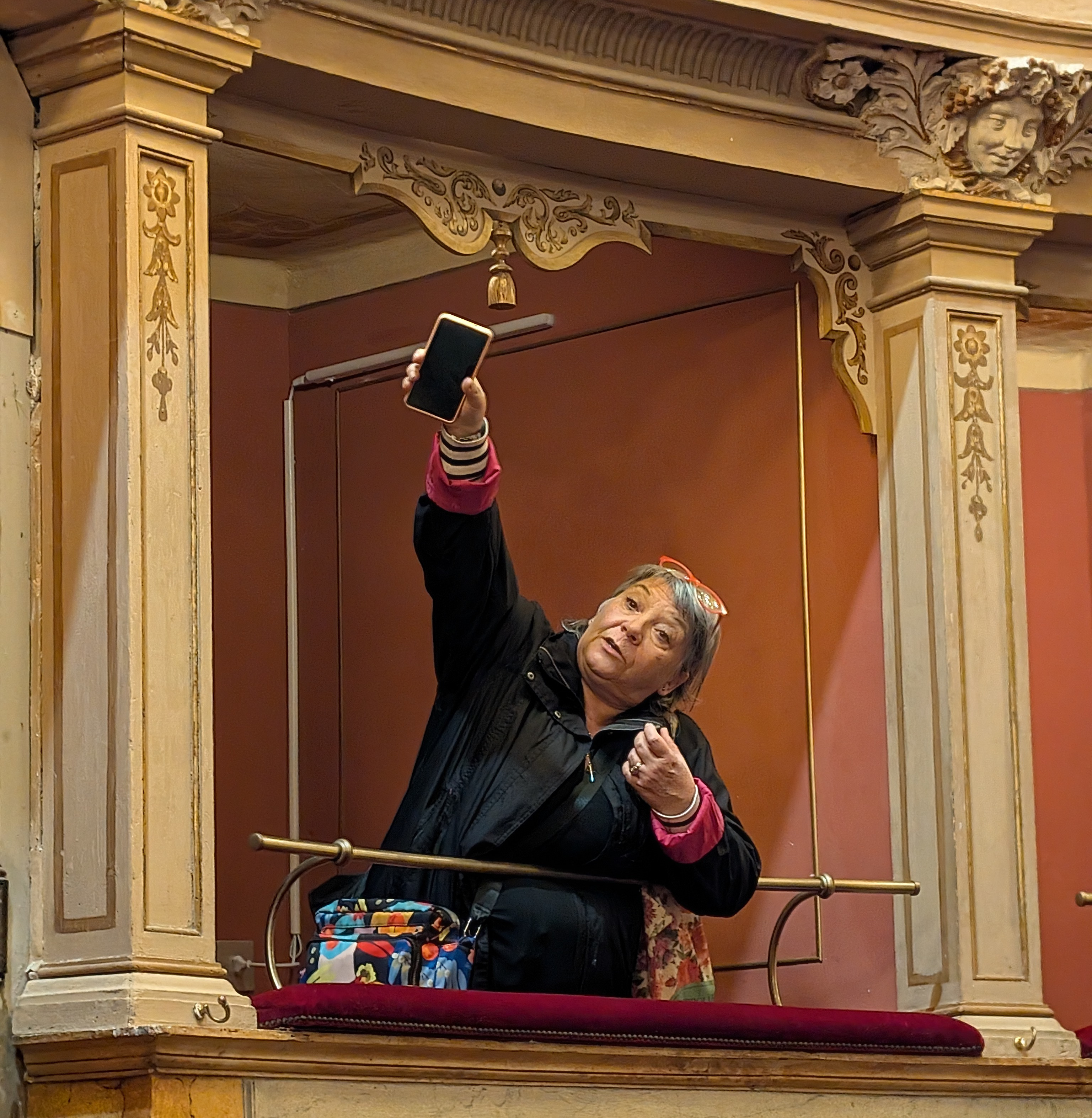
In retrospect, one challenge of this tour should have been evident from the name: "Medieval Villages". The villages we visited were the same (small) size and still had their original medieval street layout. So, we saw quite many narrow village streets which all started to look the same. After a while we stopped photographing them, but here are three. We could only tell the pictures apart by knowing which day we took them. Left: Montalcino. Center: Siena. Right: Pitigliano.
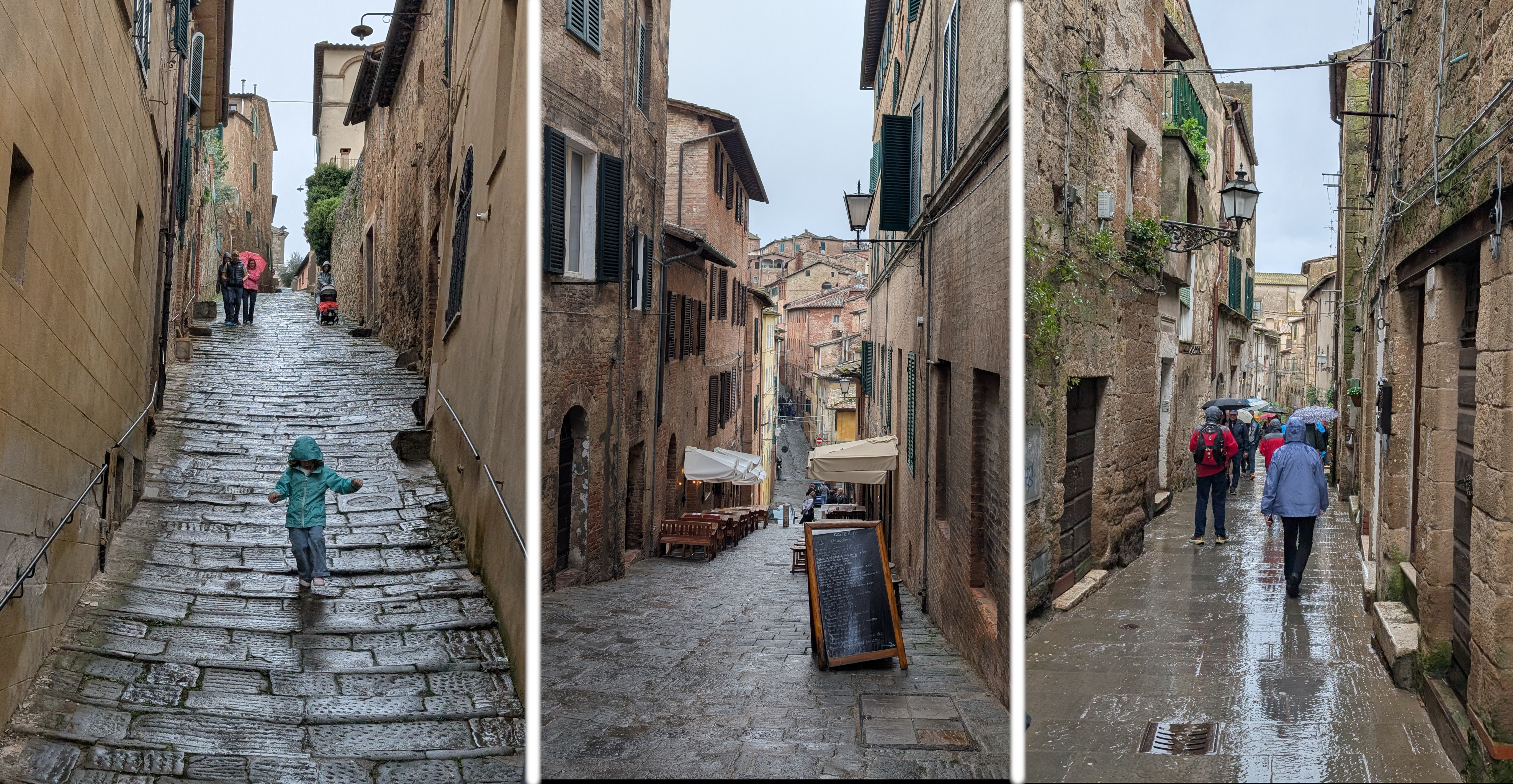
The first few days were rainy, but we saw lots of Tuscan hillside scenery. This is from the bus near Montalcino.
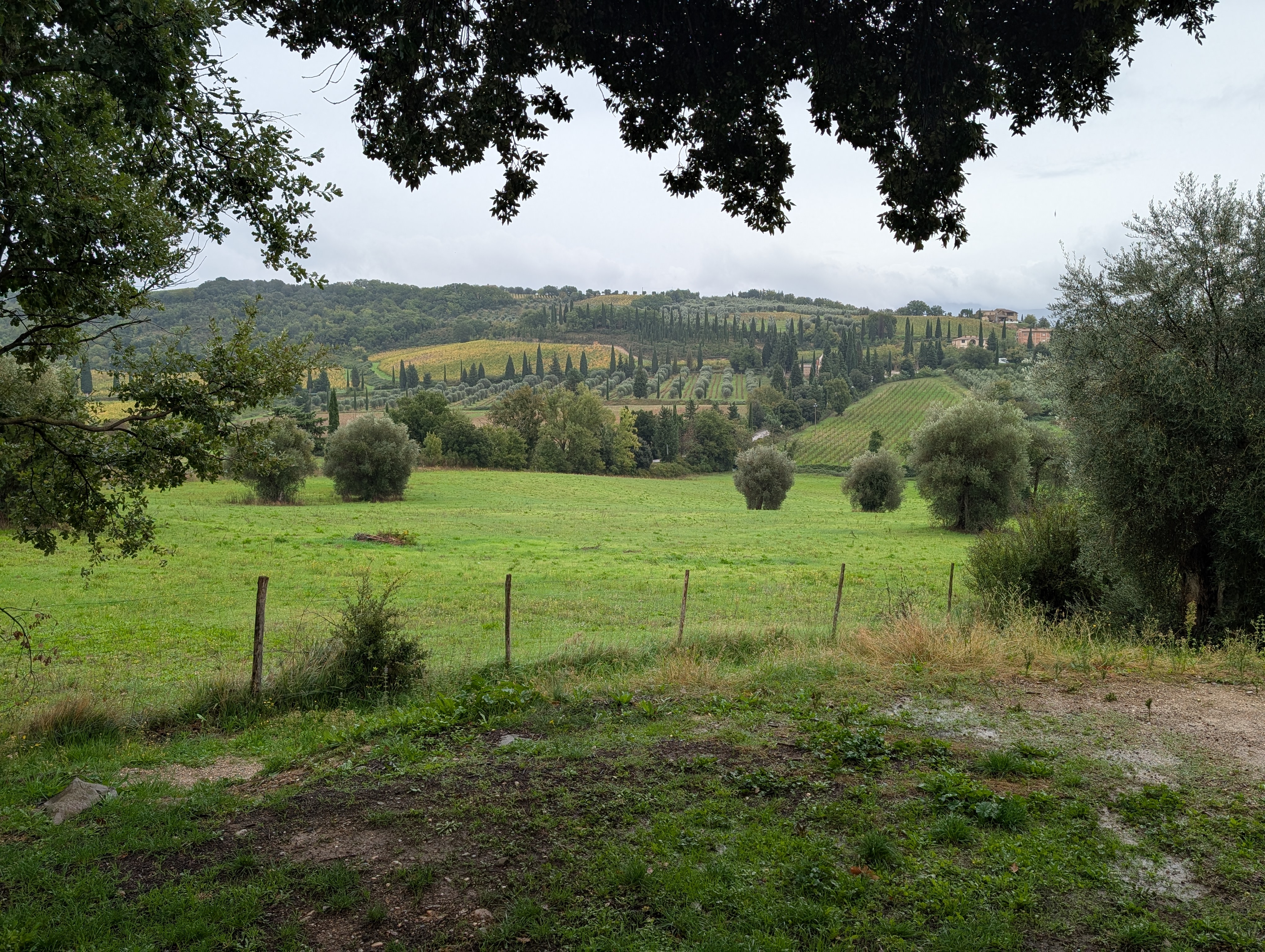
Lunch in Montalcino was at a winery owned by the Pacenti family. Their guide gave us a detailed tour of their operation. We had a delicious lunch in their tasting room. We sampled three of their wines from the same land, but different vintages: 1 year, 5 year and 10 year. Oddly, most of us preferred the 5 year, and we bought a bottle which we drank later in the trip.

In Siena, approaching the main square. You can navigate by the clock tower, as long as you can see it among the narrow streets.
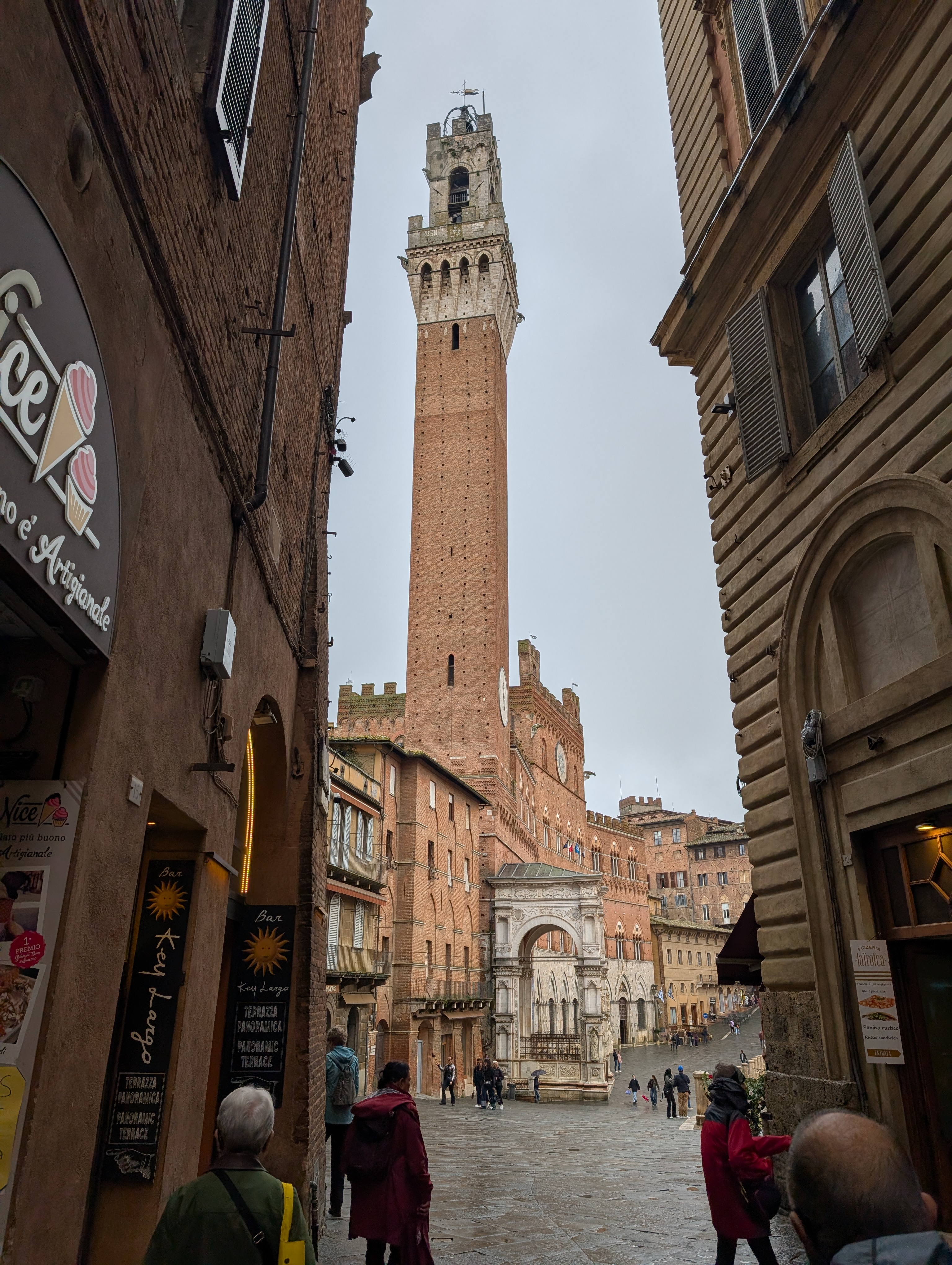
The main square of Siena, where they hold the Palio horse race twice a year. The clock tower is behind us.

In Siena, one of the many cathedrals we saw on the tour.
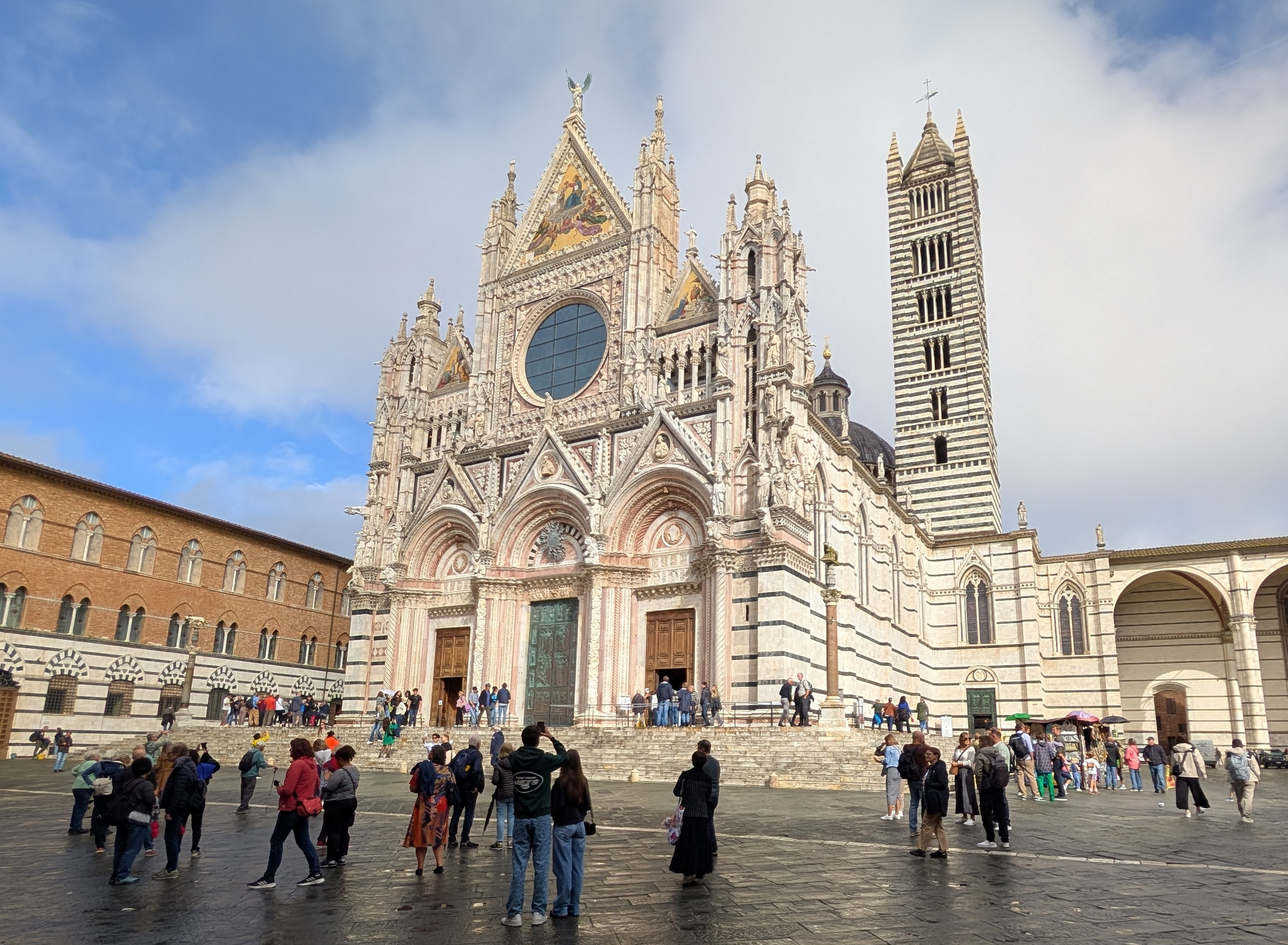
Mosaics inside the cathedral

Mosaics inside the cathedral
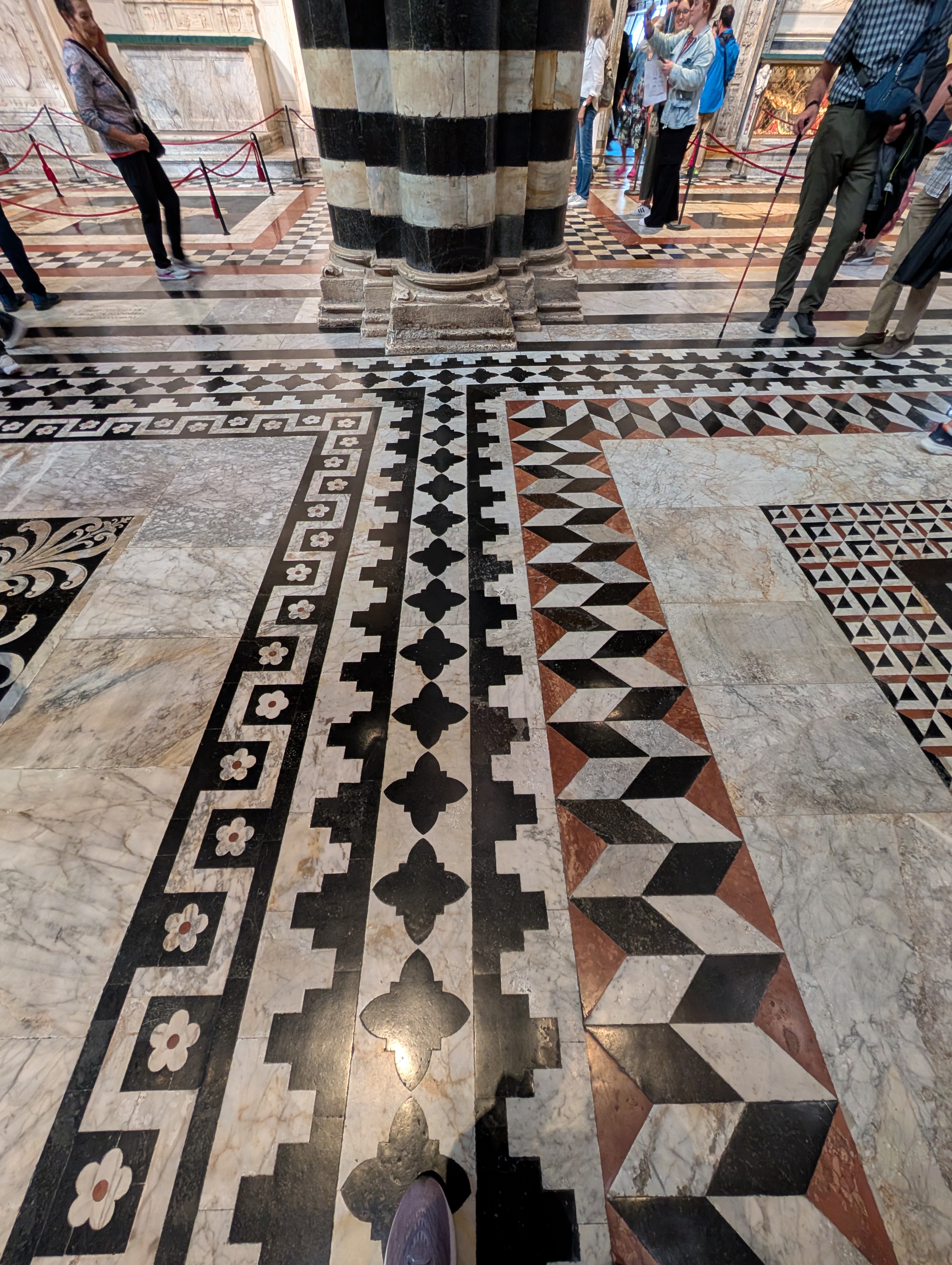
A pretty fountain in Siena
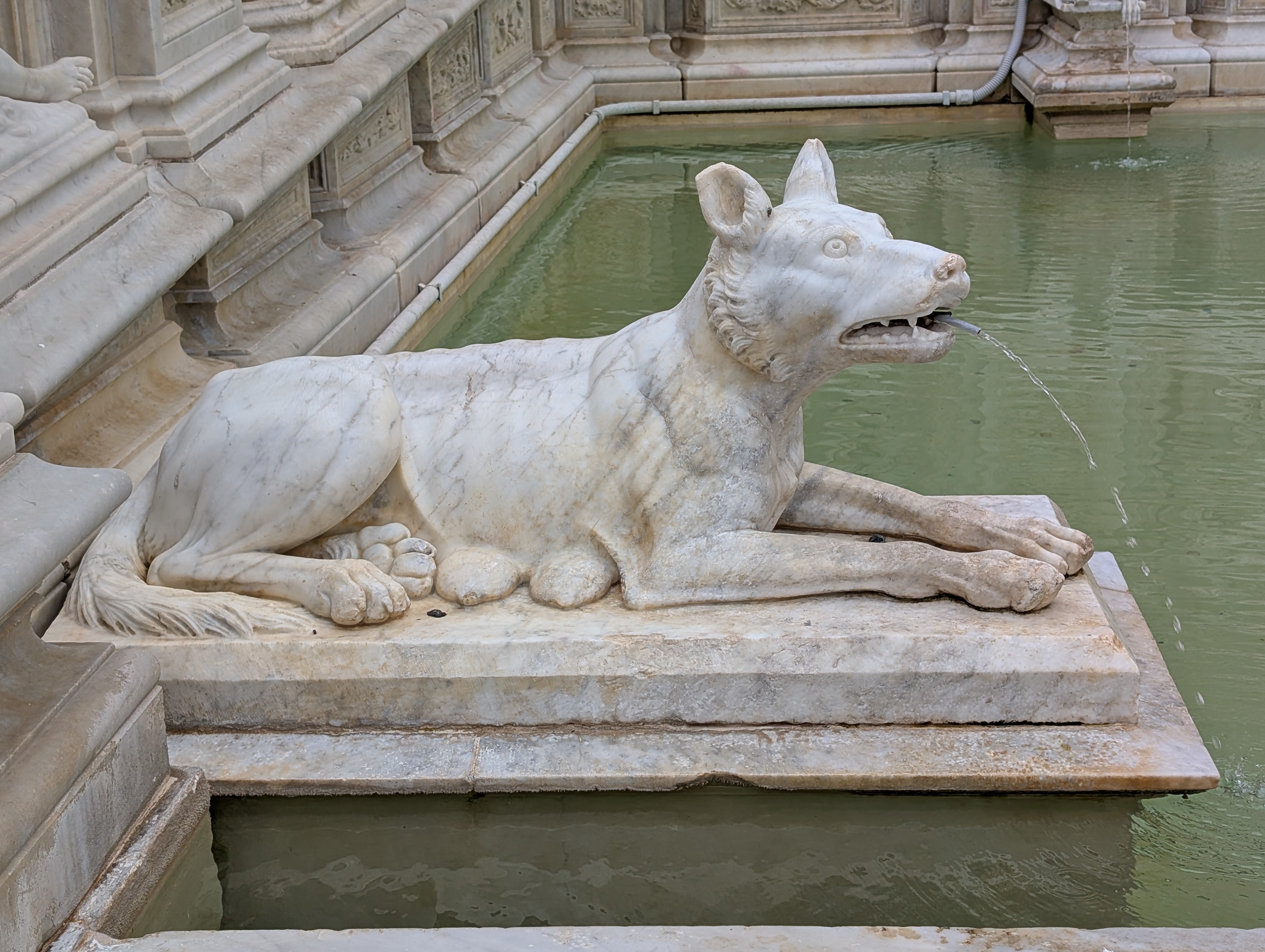
On Friday we visited Pitigliano, which was notable for its acceptance of Jews. Other cities passed laws to prevent Jews from owning property or businesses. For a while, Pitigliano resisted, and its Jewish population grew. Later they were forced to pass similar laws and create a Jewish ghetto. We visited a synagogue there, and toured an underground complex where there had been a bakery and other small businesses.
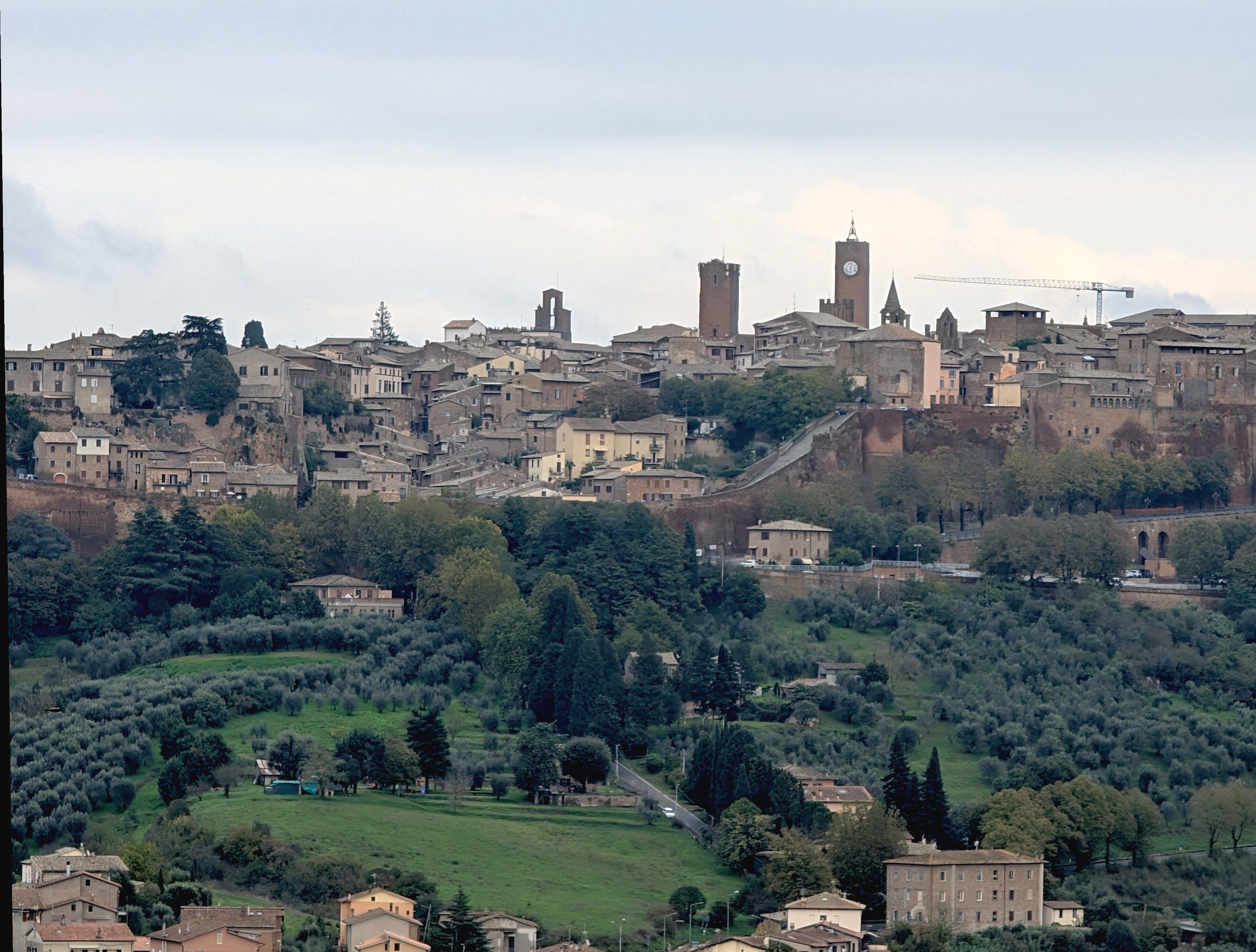
Inside the synagogue
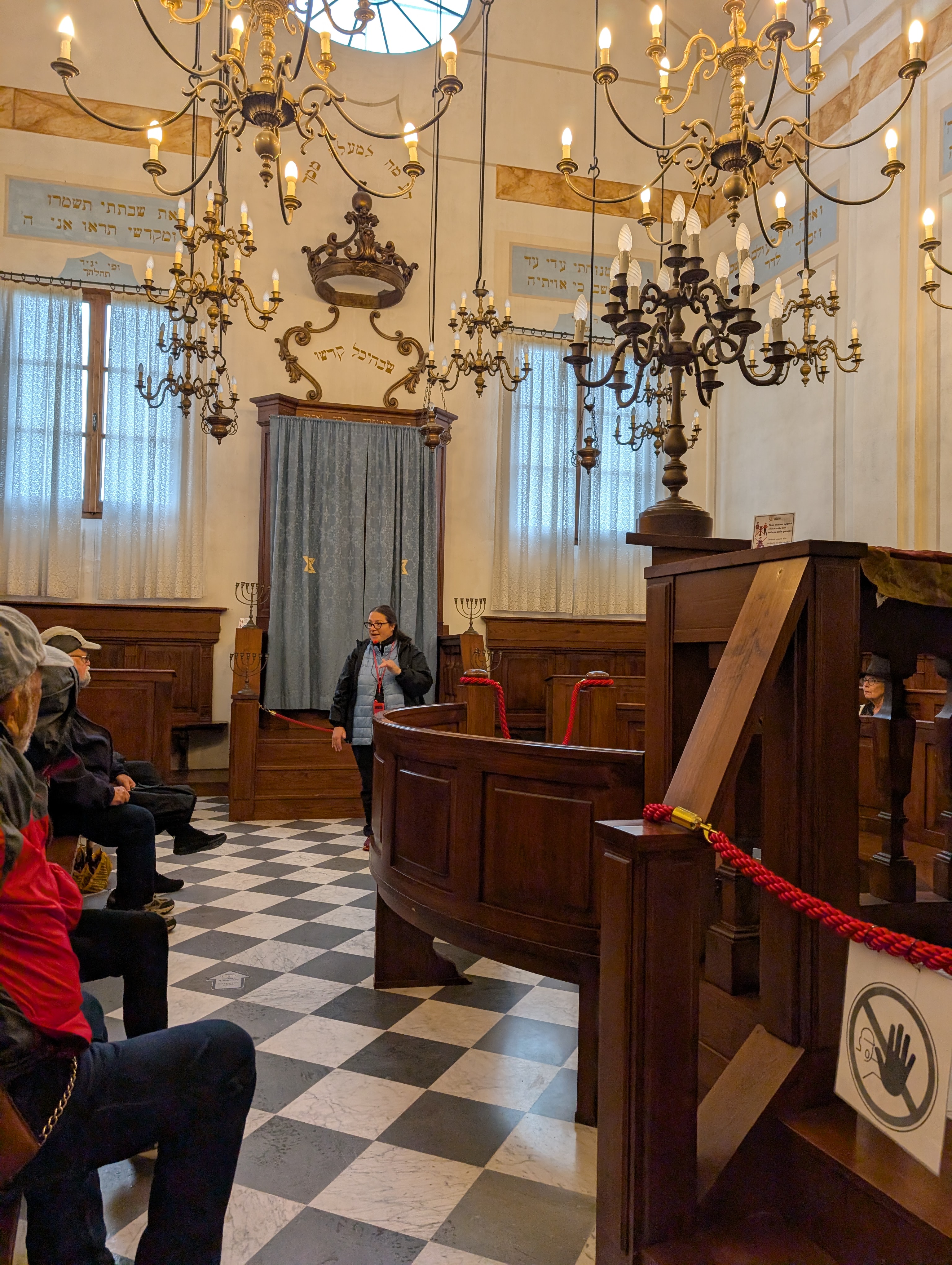
Men were required to wear a yarmulke. Also, you can see the earpiece we used for all the tours. It's called a "whisper". The guide wears a microphone and can speak into it pretty softly. Everybody in the tour can hear, which is great both for the group and for everybody else around.
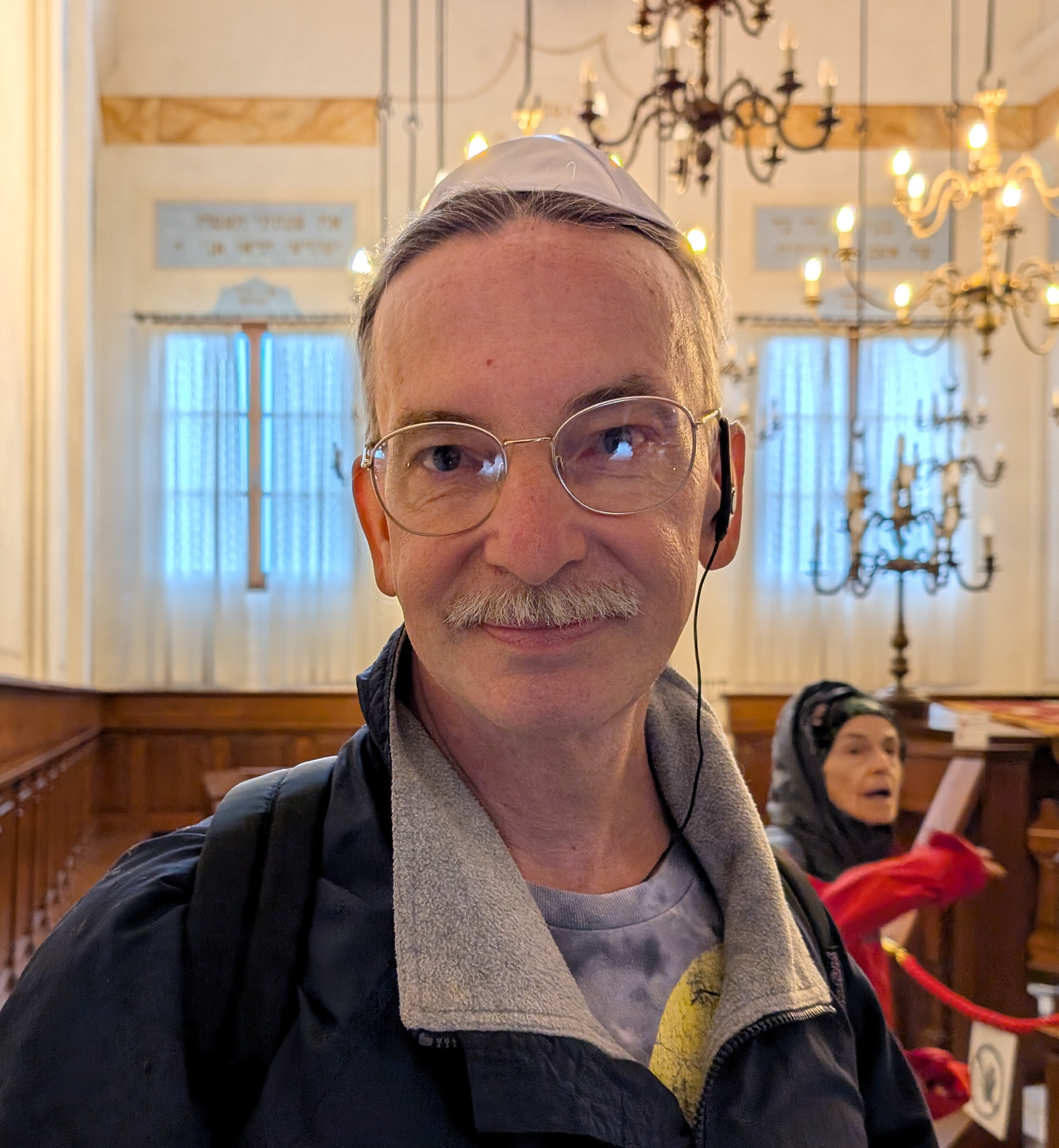
A pretty plaza in Pitigliano
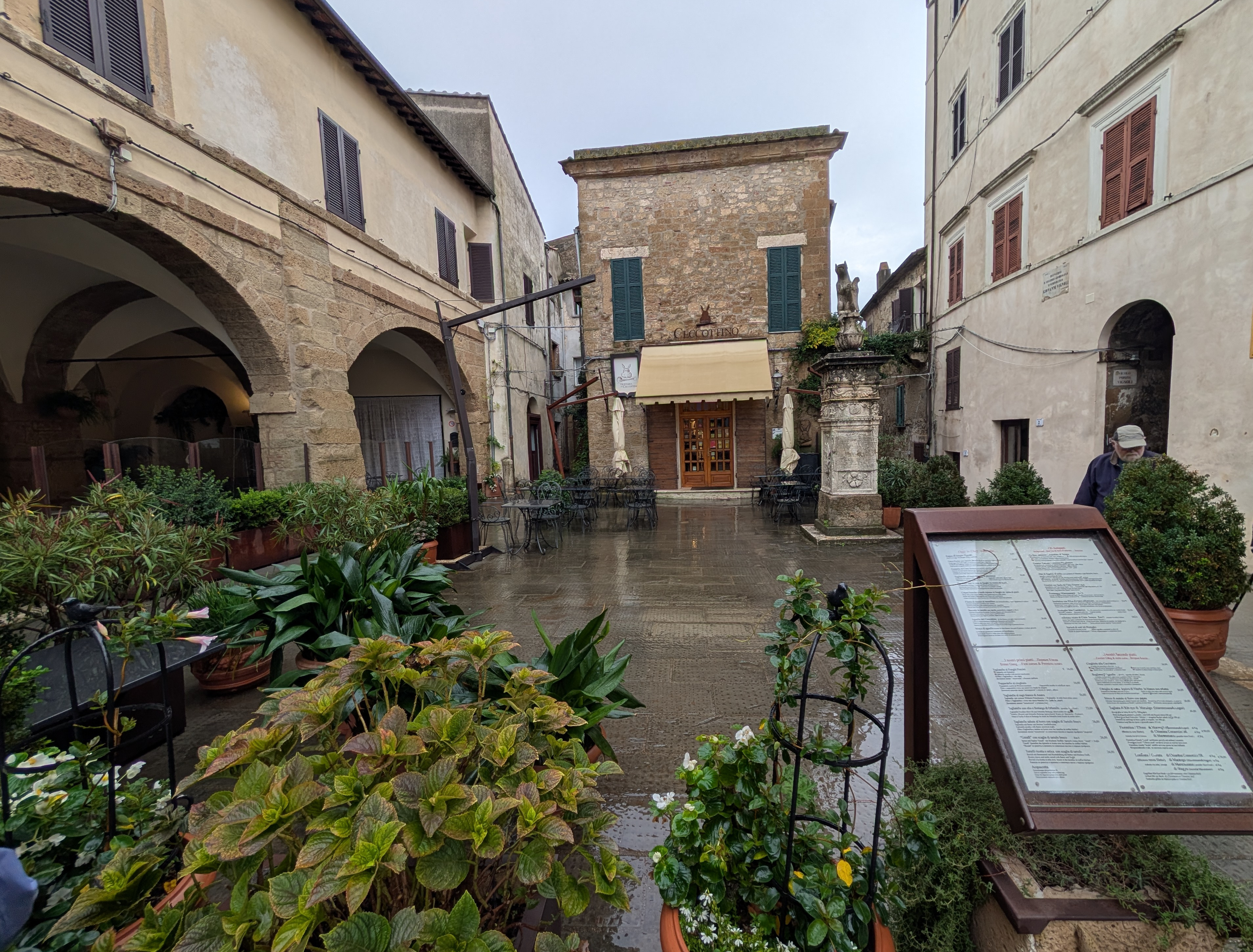
The next day we visited a small castle called Gargonza outside Cortona that the owner claimed was one of the first to get into the business of castle hospitality; they renovated many of the original rooms into small hotel rooms and they host weddings or other events. They recently reinforced and re-opened the central watchtower. It was fun to climb up to the top and survey the countryside. We didn't spot any invaders from Florence this time.
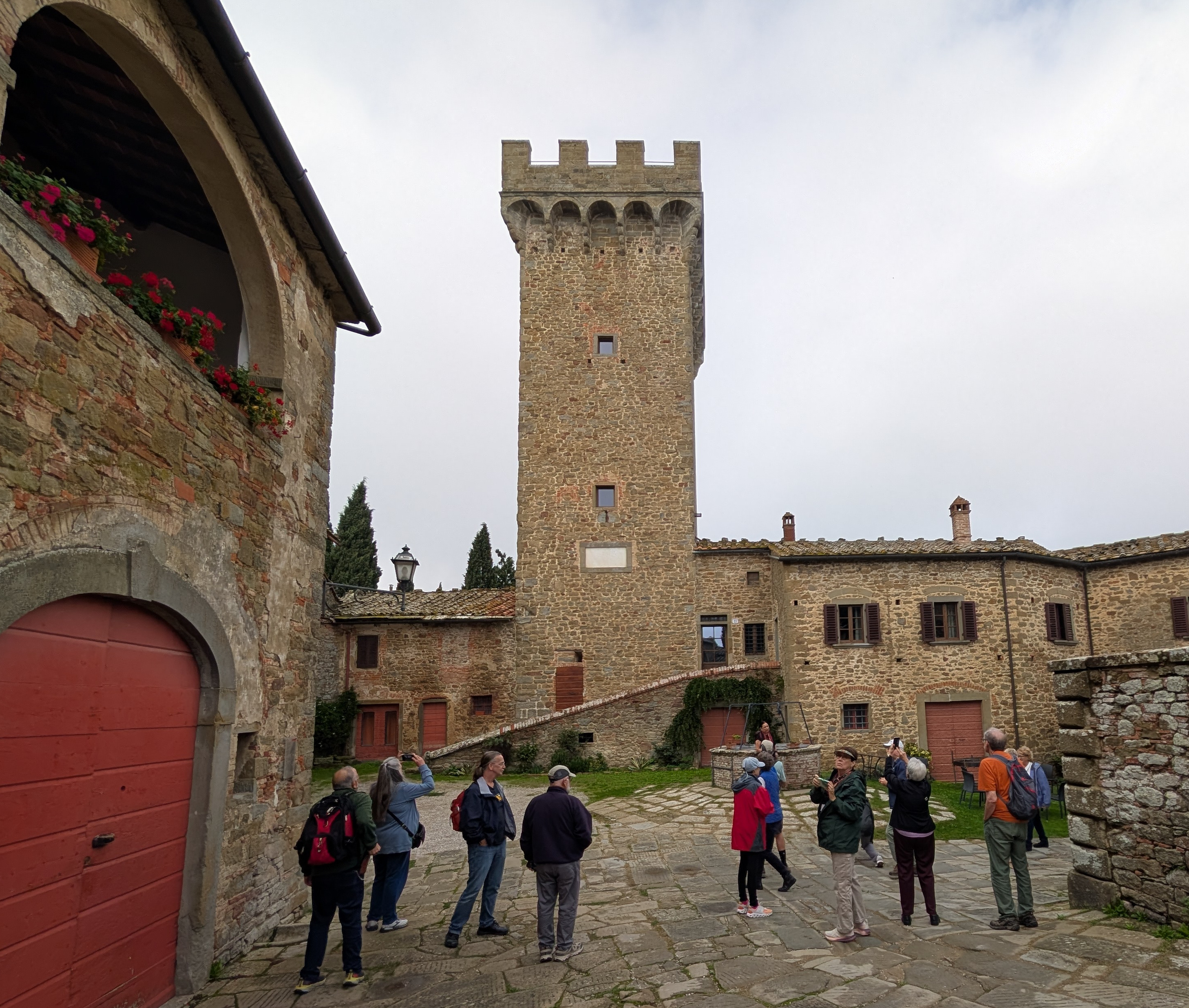
A gargoyle (dragon?) on the corner of another statue of a saint.

A view down from the hilltop at Cortana to a well preserved monastery below.
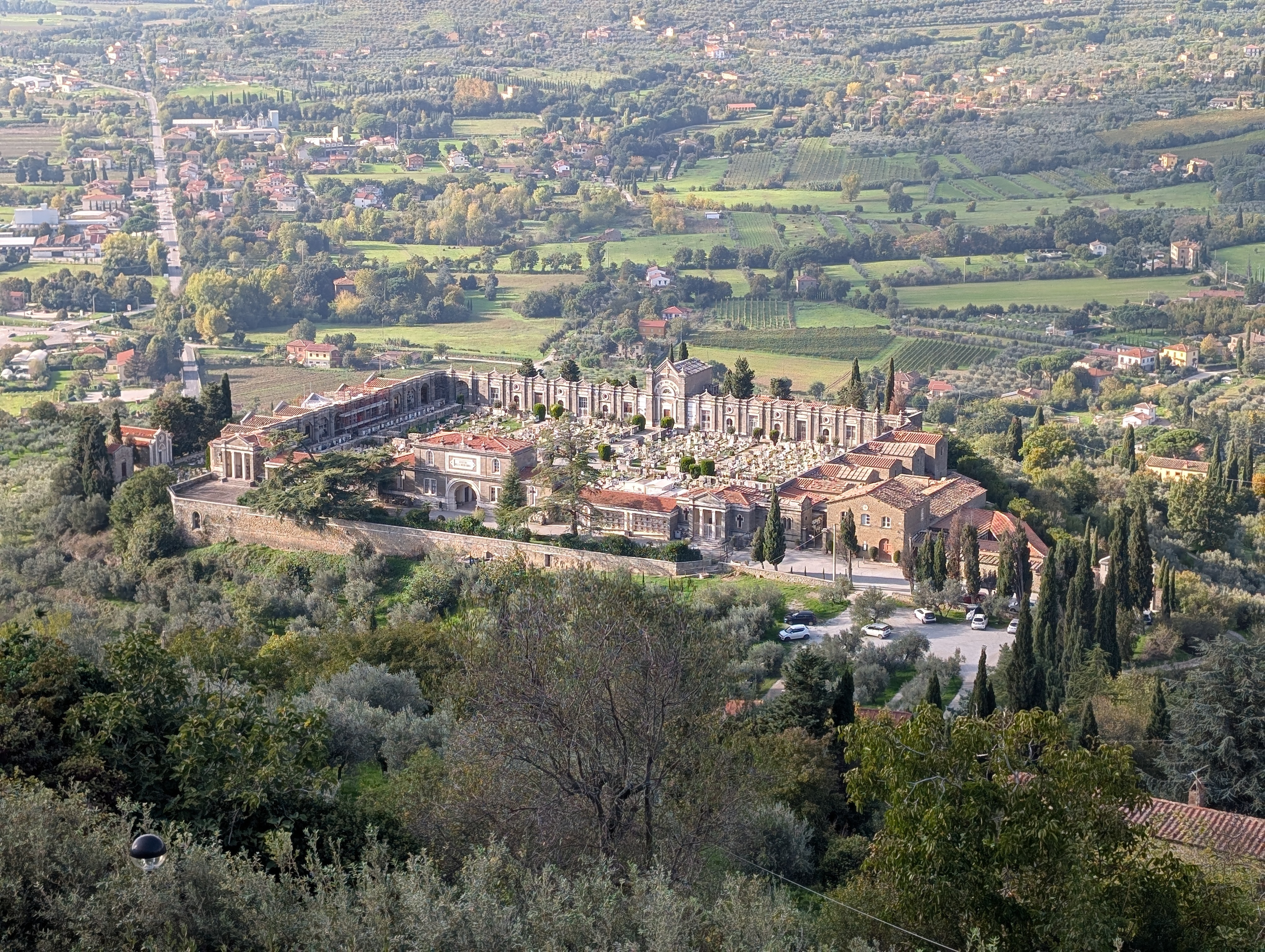
Snack time!
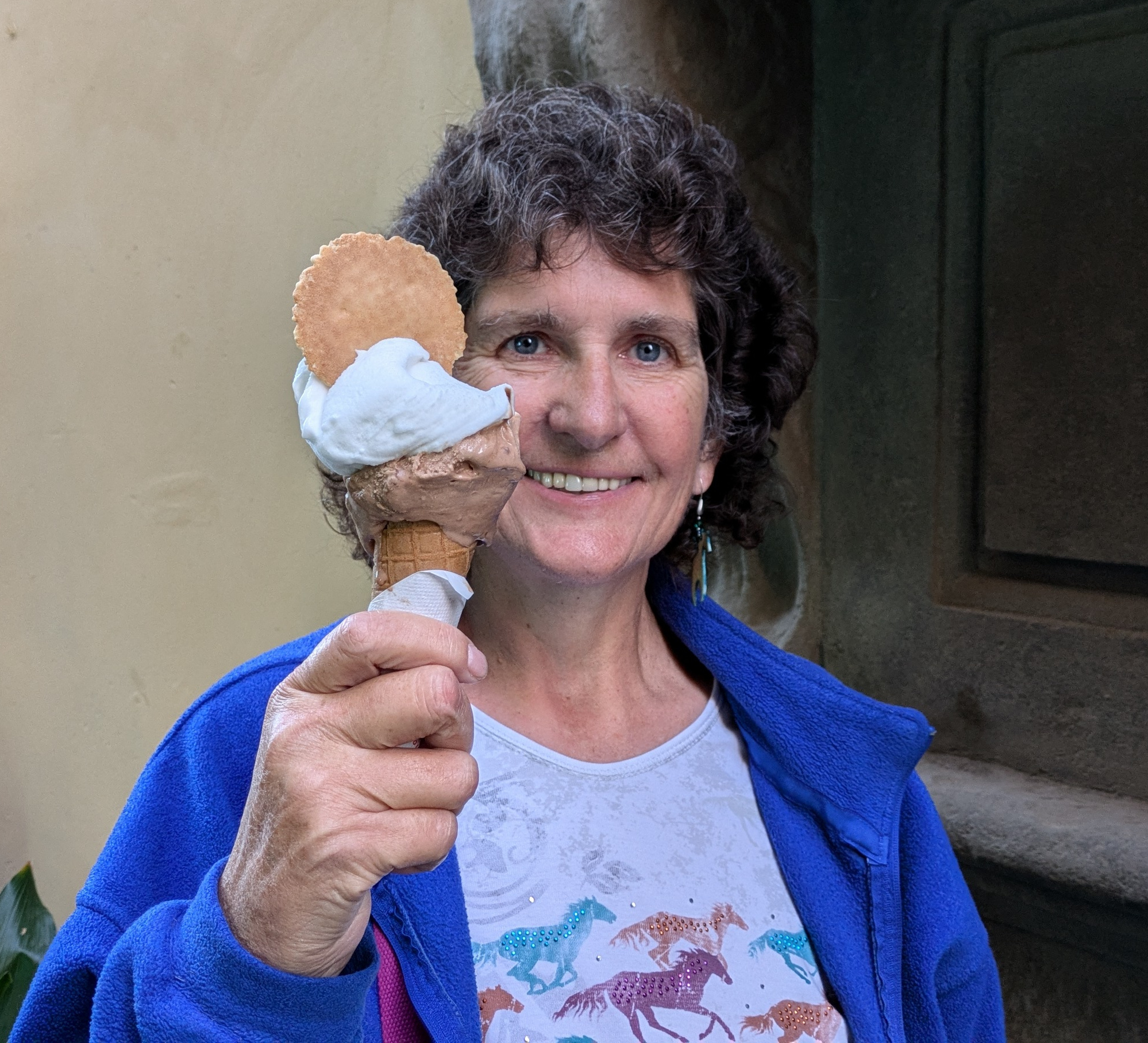
A view across from the hilltop at Gubbio. The first few days had been rainy, so seeing "partly cloudy" was a big step up.
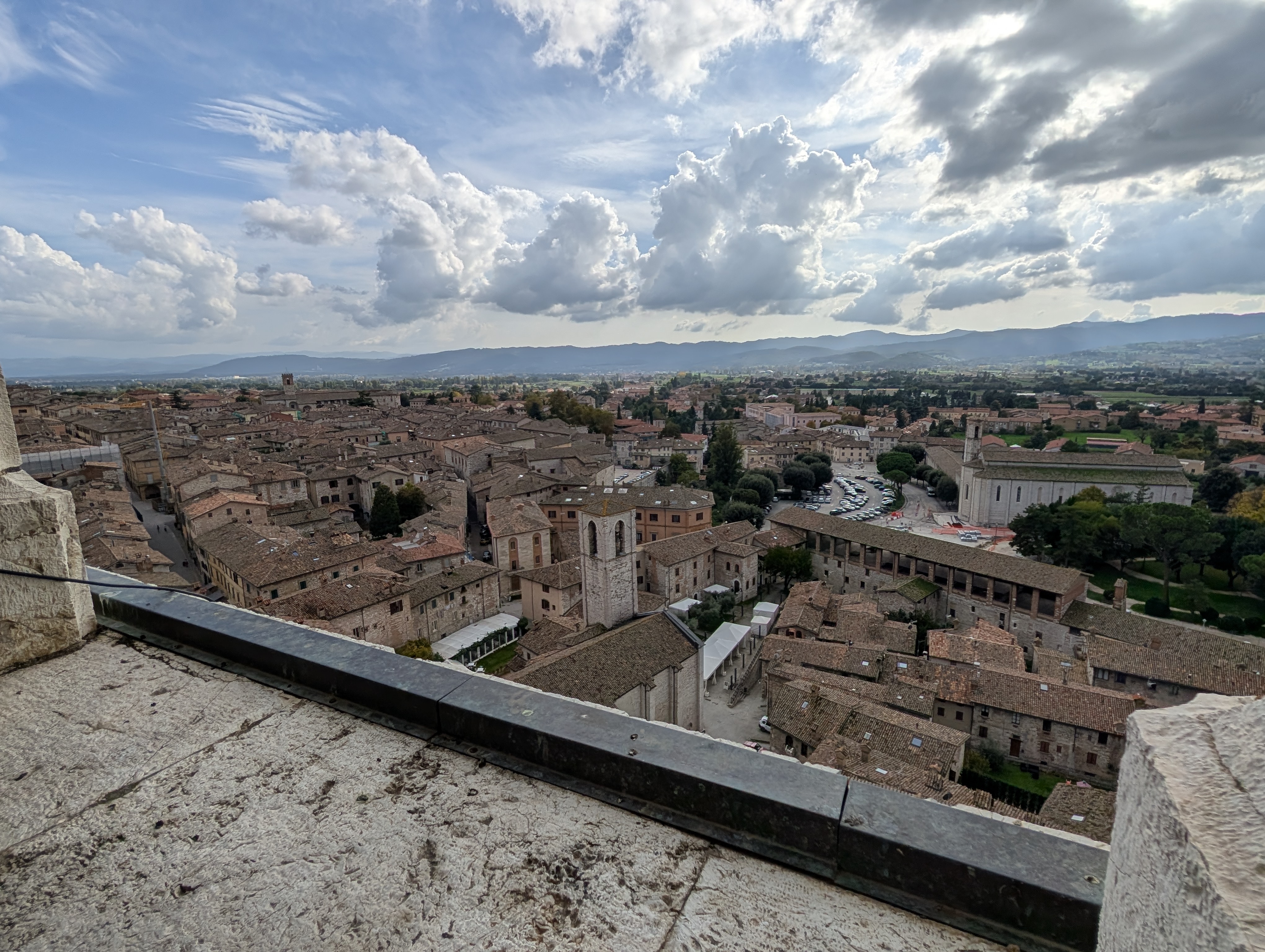
Some of the restaurants had cute packages to keep the silverware in.
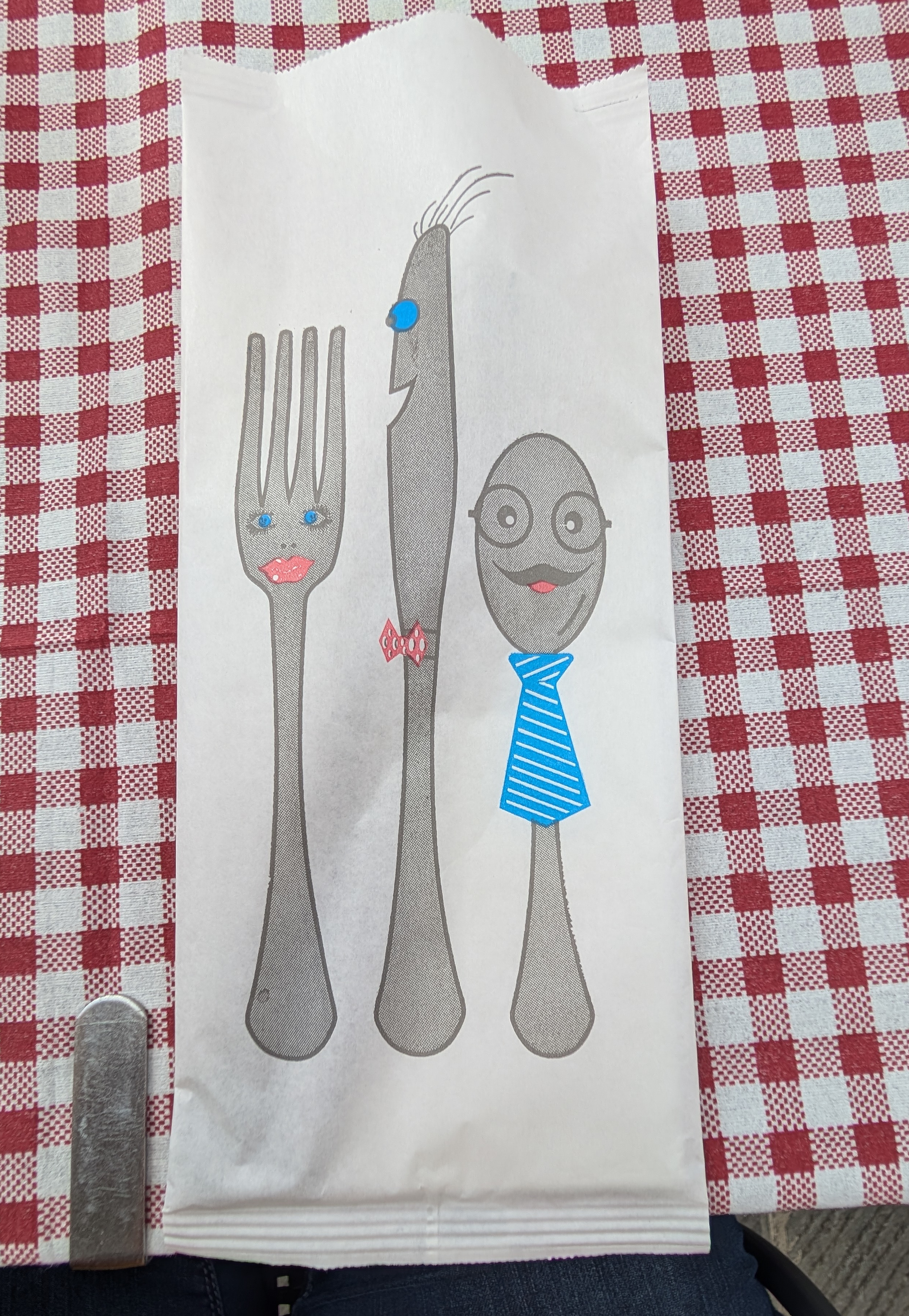
Many of the side alleys leading to private houses had gardens you could barely see from the street.
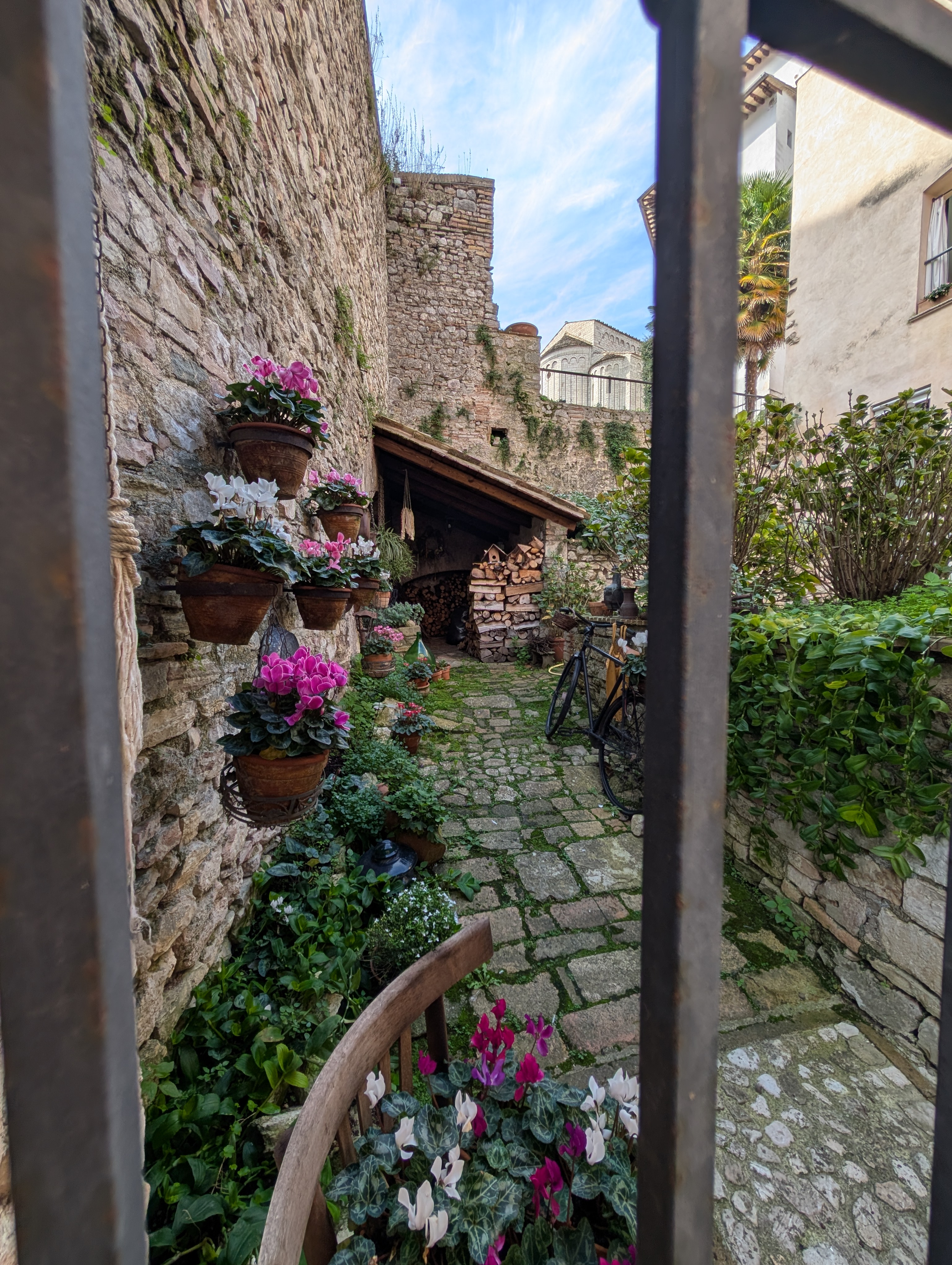
The king of Spoleto. He is imperiously ignoring the orange sunset behind him.
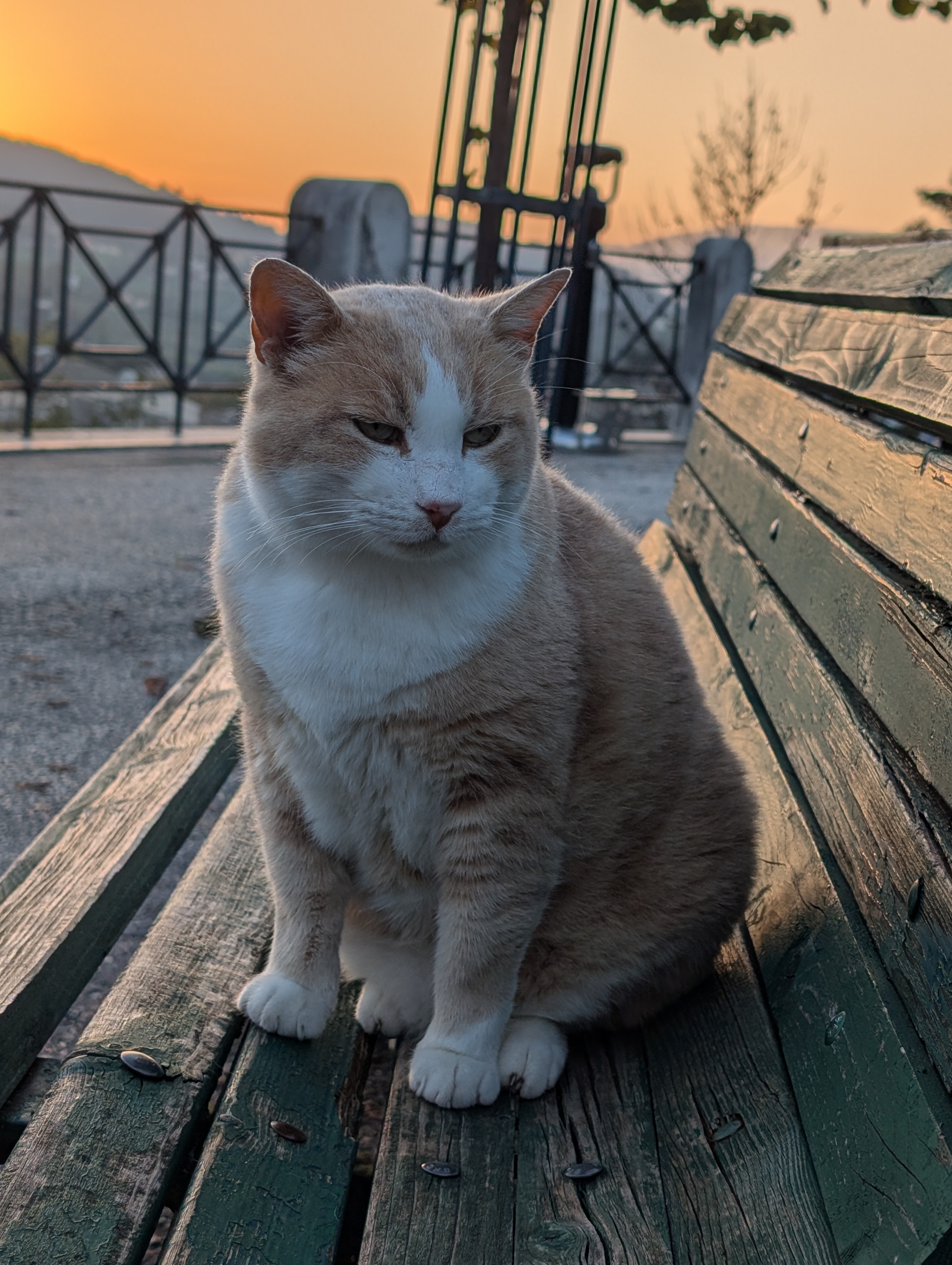
A few times, the local guides were excited by one of the local murals and spent some time telling us the whole story. In this case, it was a set of murals painted along the upper floor of a large ballroom behind the capitol building ("duomo") of Spoleto. This is one of the few panels where all the naked bits are hidden behind the convenient log. The murals show the rise of industry from human powered farms to more modern (1950s) equipment.
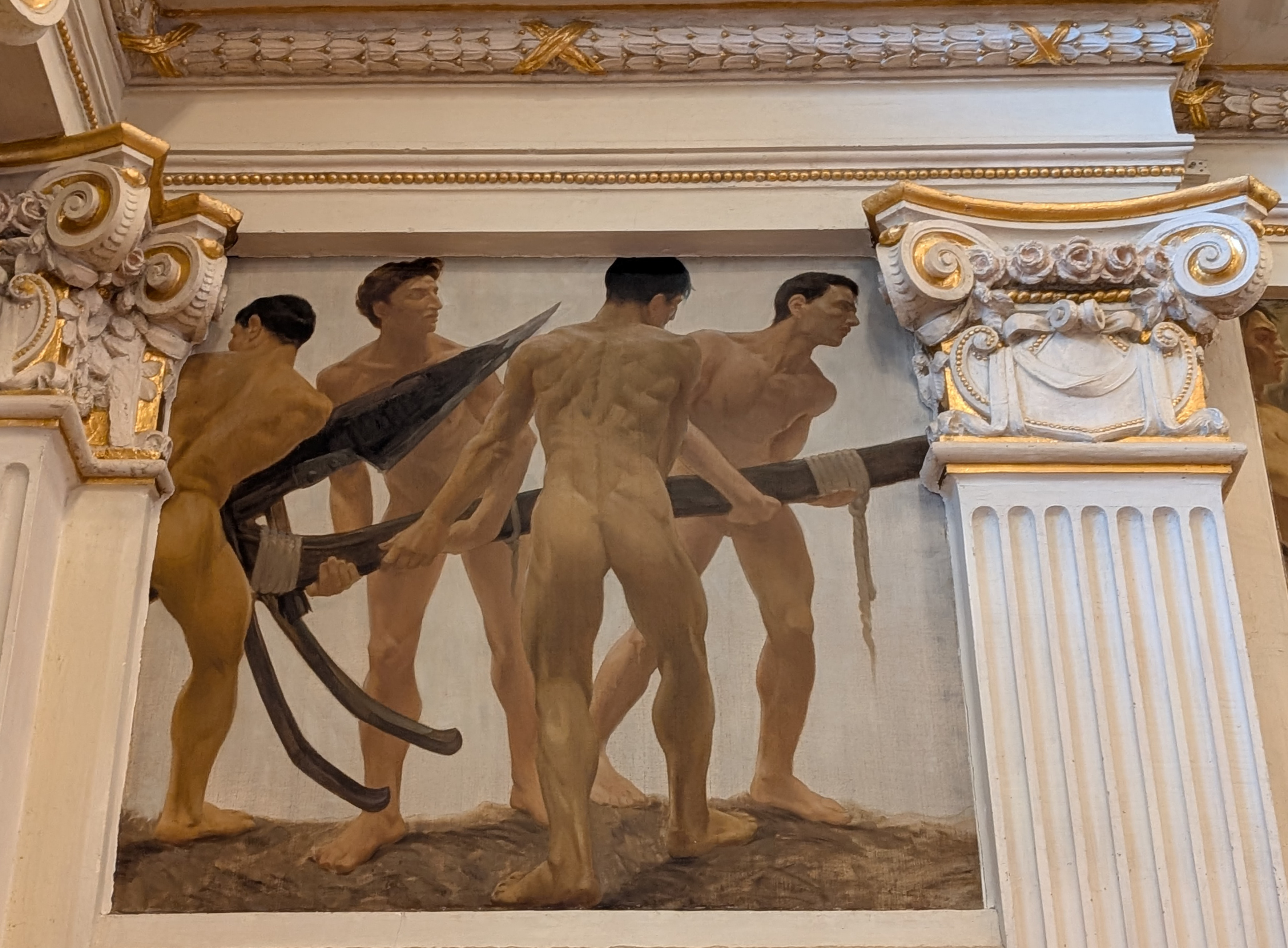
An amazing sunset Jen captured from Spoleto.
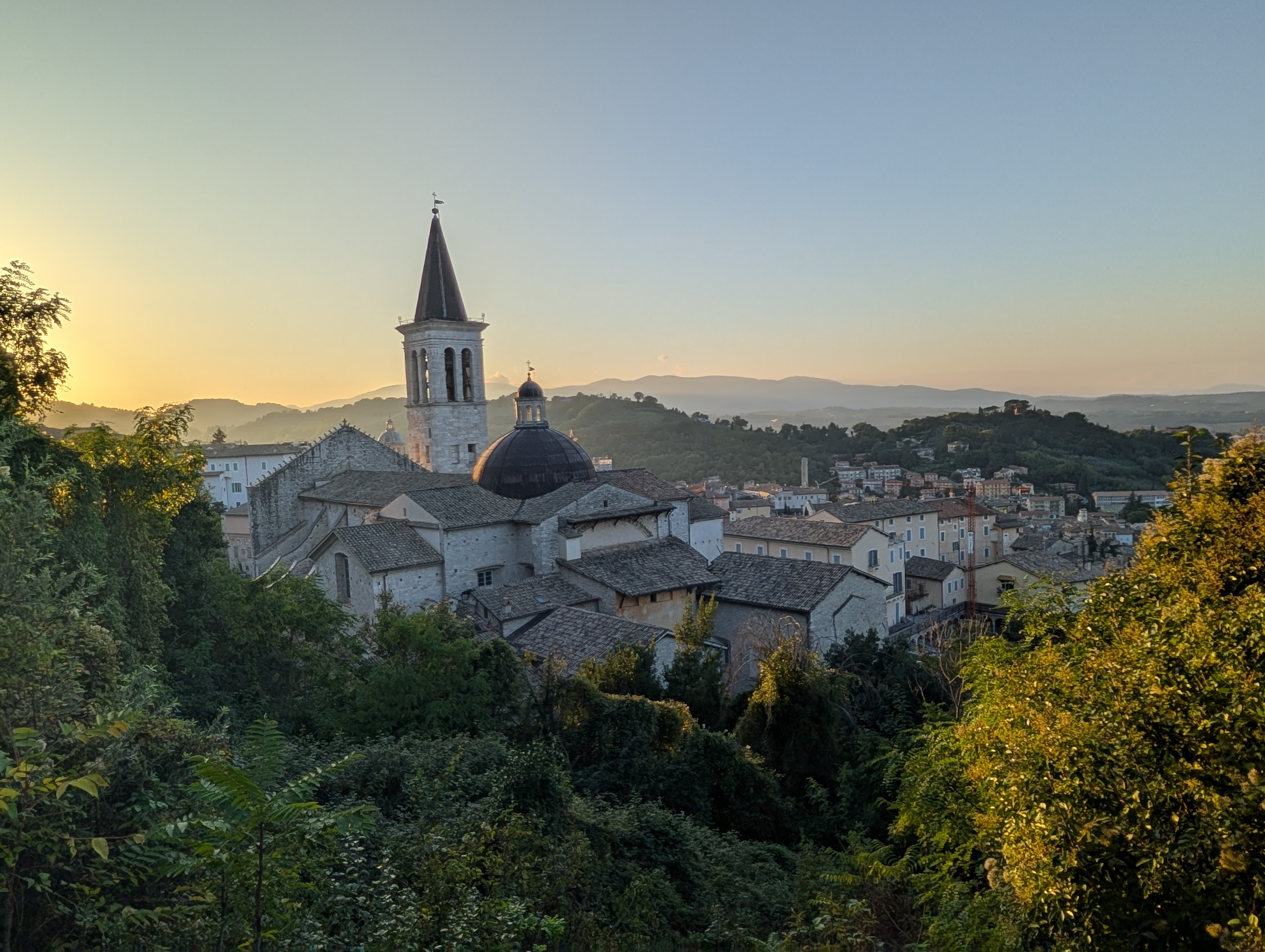
Our tour of Spoleto happened to focus on renovated theaters. Both of them are modern, so renovated from the 1910's or so. At the time, it was common to have a custom painting on the stage curtain, showing the history or important saints of the town. That way, parents could teach their children about the town while waiting for the play to start.
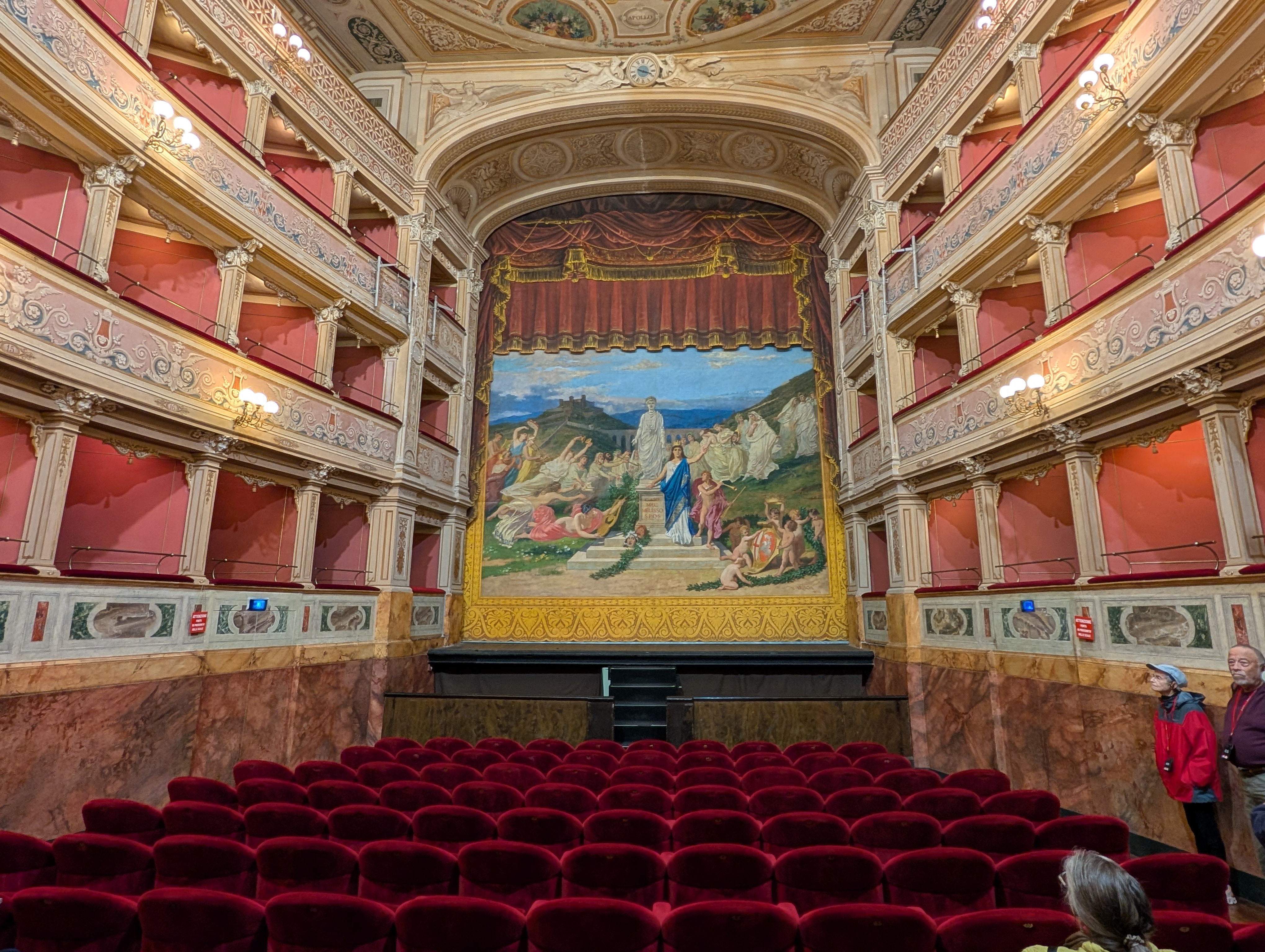
The morning we arrived at Assisi, it was very foggy. From a short distance, we couldn't see the tower at all. Then we realized it was over four stories tall.

The entrance to the basilica of St Francis in Assisi. You can see some horizontal metal rods across the archway. This is to reinforce the structure against possible earthquakes. We saw a lot of this type of reinforcement, on both public and private buildings.

Unsurprisingly, the shops in Assisi sell a lot of curios with saints. Wait, are those Saint Geralt and Saint Strange at the top? I don't think they are canon.

Not all the representations of St Francis were painted curios. This was an intriguing wood sculpture version.
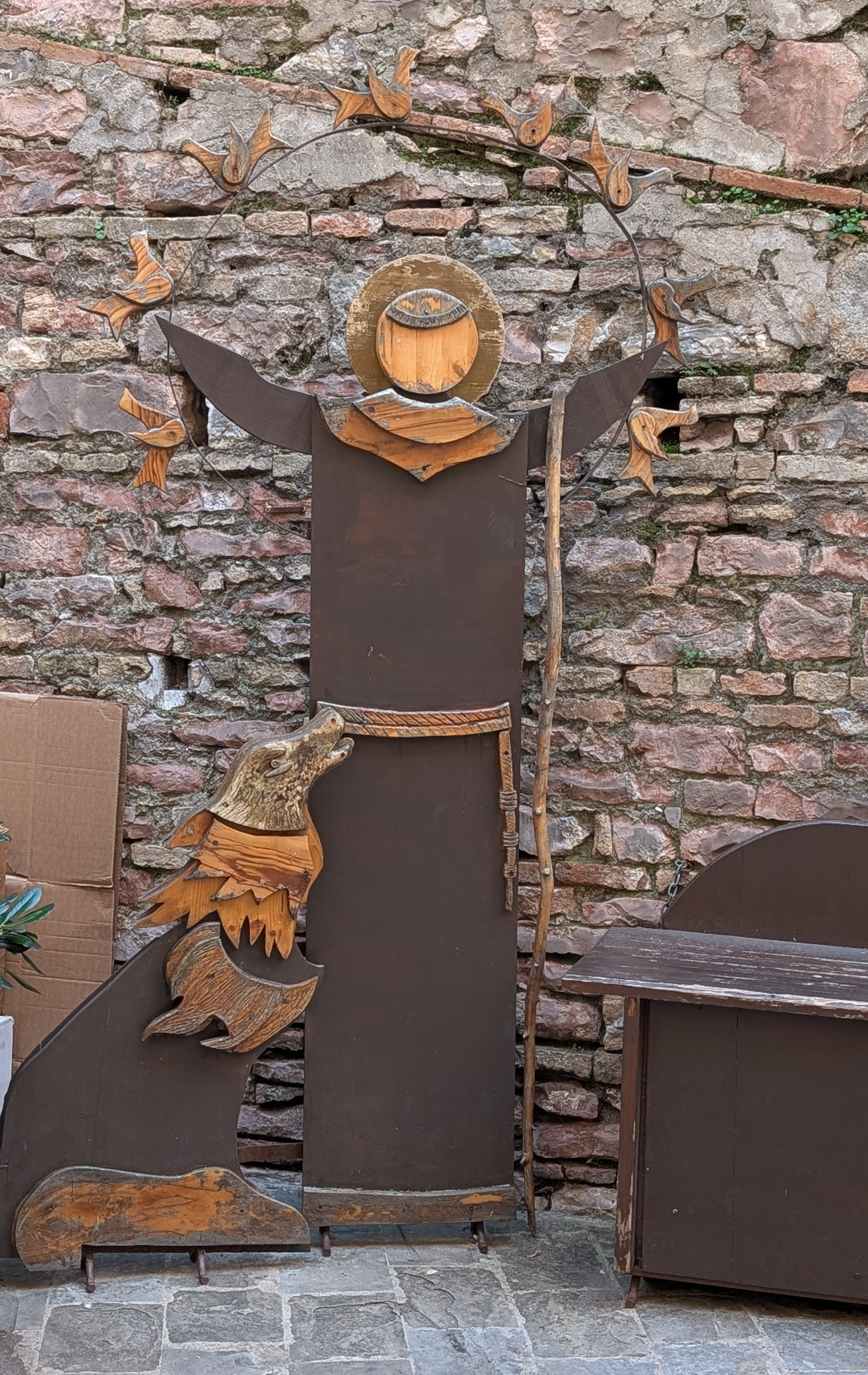
Another hill town with grape vines in the foreground, Perugia in this case.

Perugia, from the top of the duomo.

One of our favorite side tours was to the Studio Moretti Caselli, a stained glass workshop. In the 1850's, Caselli developed a new technique for making stained glass, where the pigments were actually fused into the glass in a hot furnace. It's difficult and time consuming but much more durable than simply painting on the glass. The narrator is the husband of the fifth generation descendant of Caselli, and they kept the tradition for more than 150 years. The master work shown here was done by the original Caselli in 1880, and it shows the first queen of Italy, Queen Margherita. The metal strips required to keep it secure are carefully hidden, for example among te folds of her dress.

The last town we visited on the tour was Orvieto. We had come to expect the local guides spending a lot of time telling us about frescoes. This time, the cathedral had a stunning set by Luca Signorelli in the late 1400s, showing the stages of the Last Judgement. Here we see the Resurrection of the Dead. Art historians agree that the more famous frescoes done by Michelangelo in the 1540's were largely inspired by this piece.

The guide also went into a lot of detail about all the saints shown on the front of the cathedral. The priests could use these to teach children about the saints.
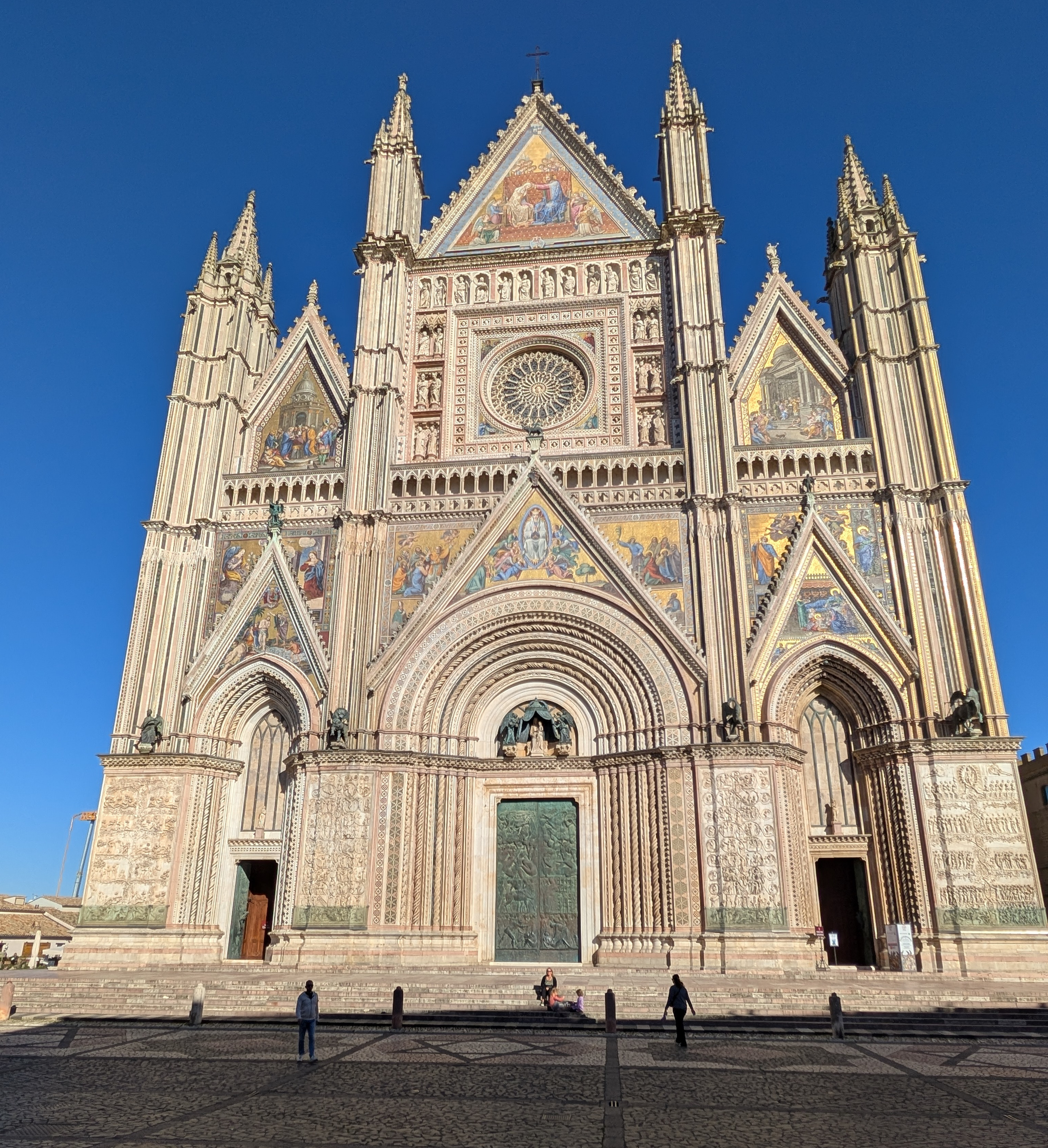
We added a few days onto the tour to spend some time around Sorrento, arriving by train to Naples and then the Circumvesuviana (subway). We went to Pompeii by subway, to Capri and the Blue Grotto by boat, and along the Amalfi coast by bus.
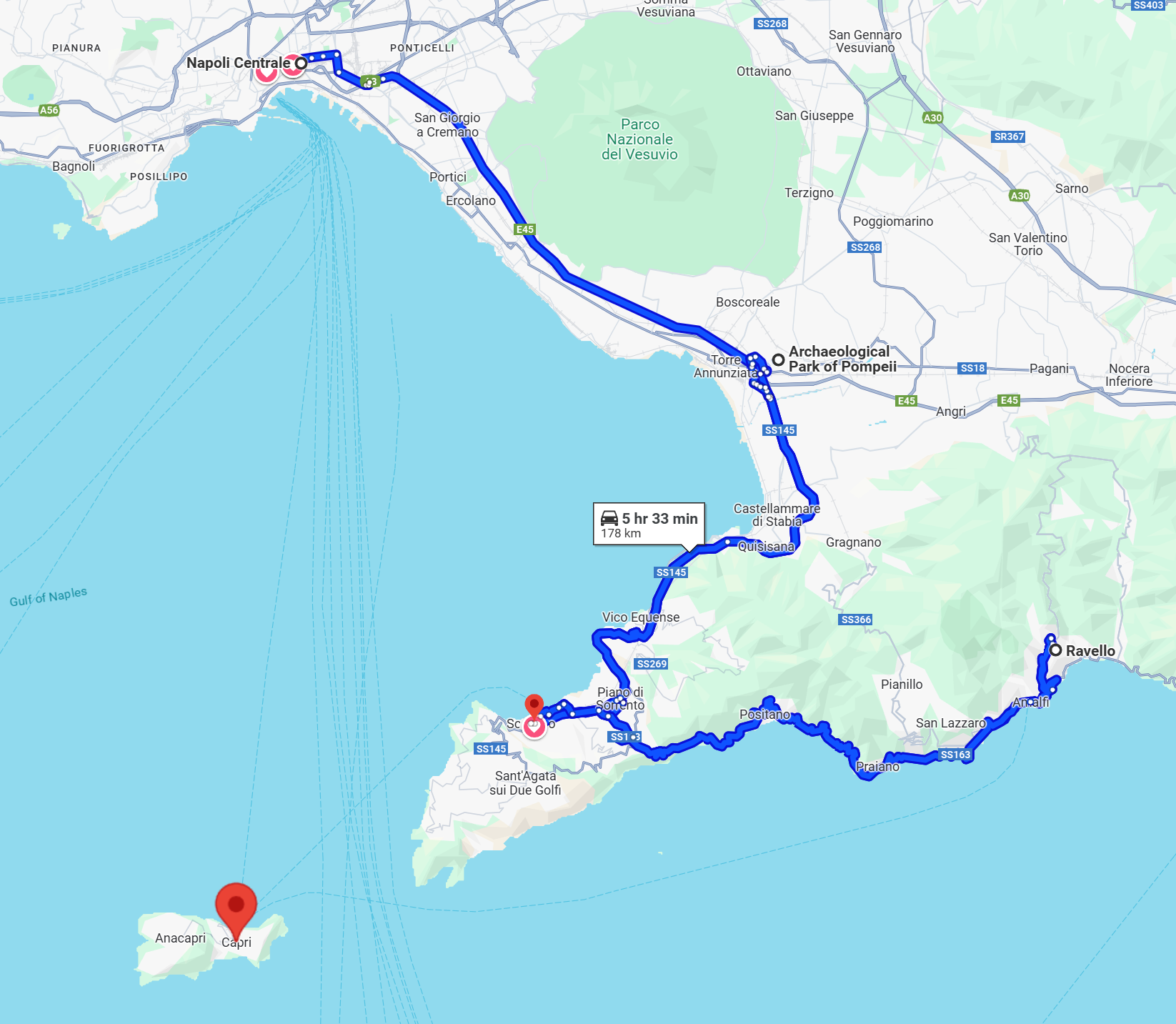
We had been to Pompeii in 2005, but we went around on our own with our trusty Rick Steves guide to Italy. That was good, but this time we joined a guided tour. It was two hours, with about 40 other tourists, but fortunately they also used the "whisper" system so we could hear easily. The guide took us to the 10-12 most popular sites, including the market, the baths, and at least one brothel. It was fast paced, so we did not have much opportunity to photograph; but these sites are pretty well known. After the guided tour, we enjoyed a bag lunch we had packed in, and then spent a few more hours exploring. Here is a shot of one garden. We are "pretty sure" that in 2005 Dave took a picture of Jen at the other side of this same garden, but we'll never know for sure.

Our next stop was an all day boat tour to Capri, with a stop at the Blue Grotto. We went to the grotto as soon as possible to avoid crowds. Our trip was during "shoulder season", but it was good we were on a "small boat" less than 8 people. Larger boats have to wait longer, and in summer you can wait 3-4 hours. We made a video of the way you go in and out of the grotto, plus a little video of inside. It was pretty amazing. If you go to youtube and find our channel "davidlallenw", find "italy appendices: blue grotto" in the Italy playlist.
They can fit 3-4 people per rowboat, but you have to sit on the floor of the boat while the pilot stands over you. So, Dave took this picture of his view back from the front of the boat. Those are the pilot's legs. The view from inside the grotto was a little nicer. You can definitely see why it's called the blue grotto, because the sun shining into the water makes it a beautiful sapphire blue.
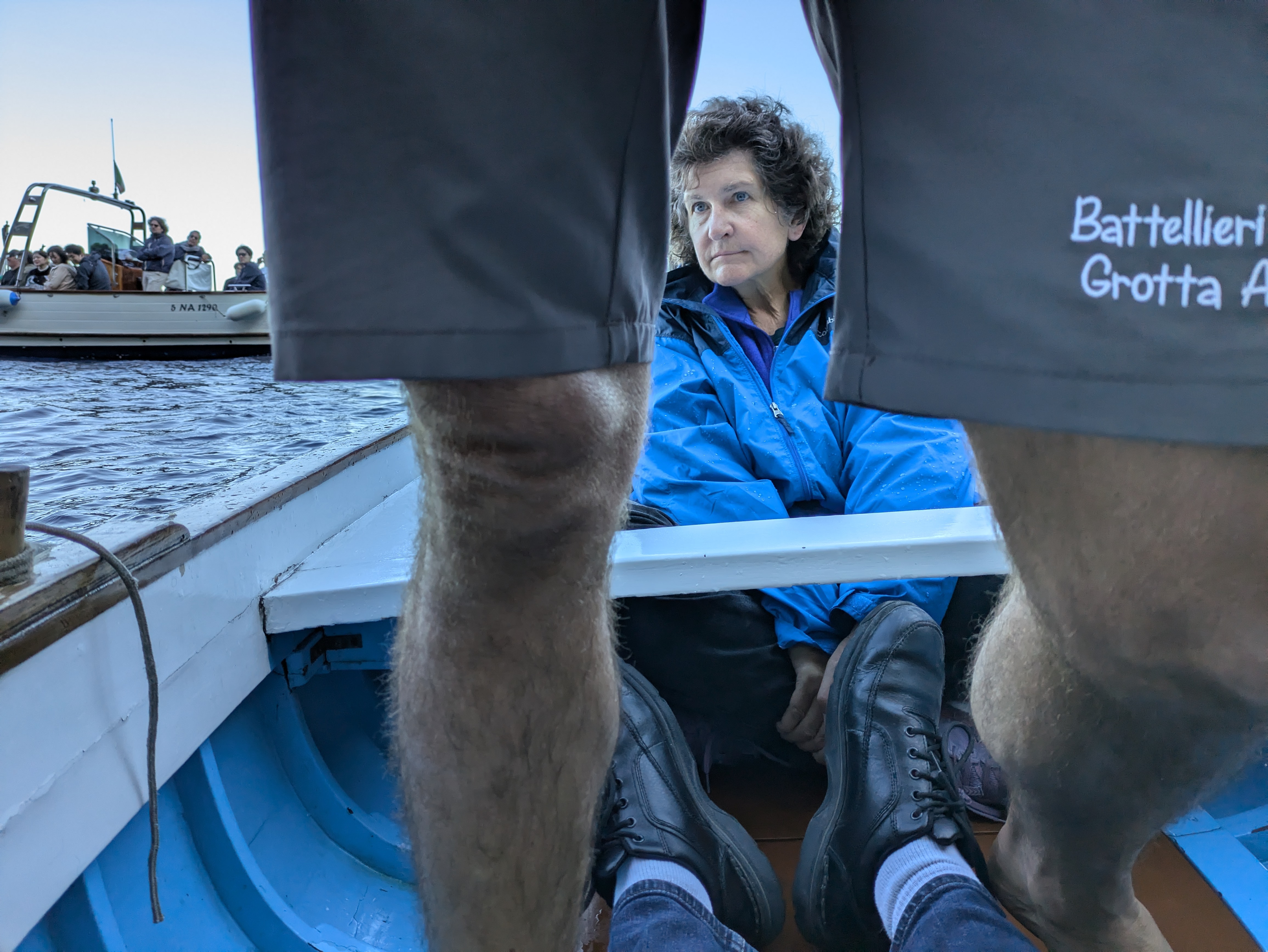
Blue Grotto was the high point of the day, but the cruise continued around the island to see some other caves. The captain was great at maneuvering the boat into some of the larger caves so we could see other boats go by.
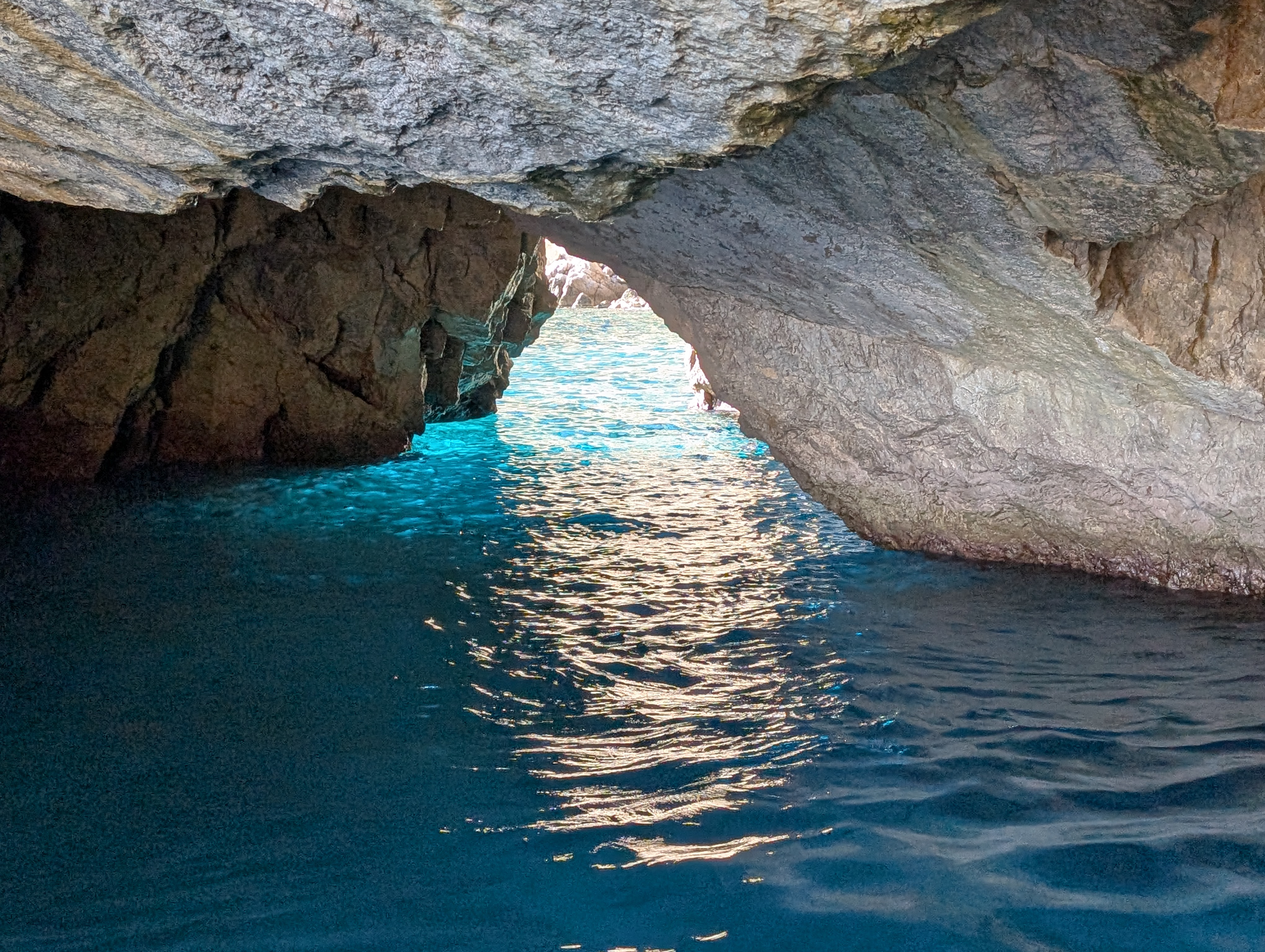
It was interesting that some of the caves had blue light and some had green.
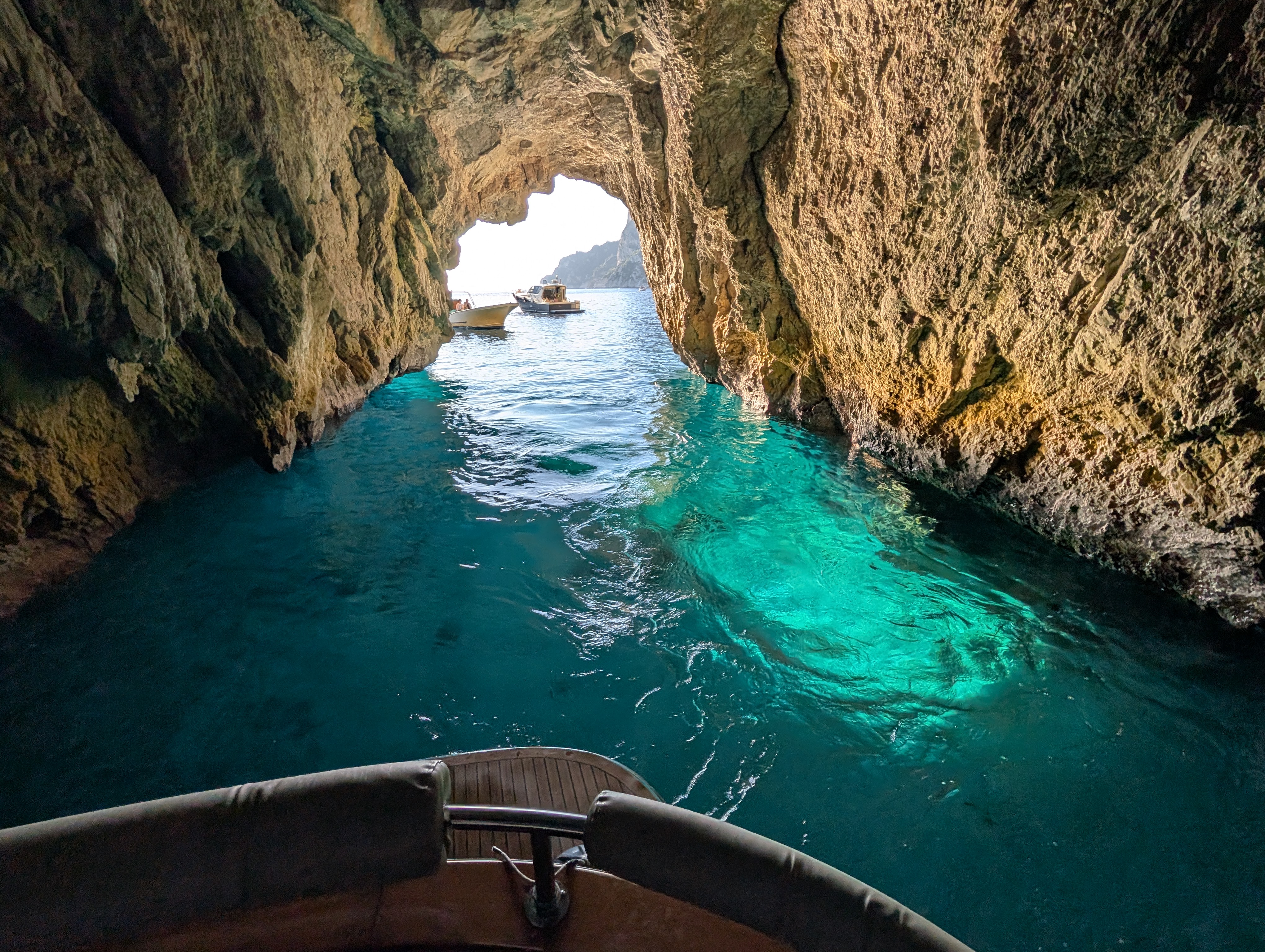
The Faraglioni Rock Stacks. The guide told us that if you kiss your sweetheart while passing through the arch, your love will be eternal. It may take a while for us to be sure if it did anything.
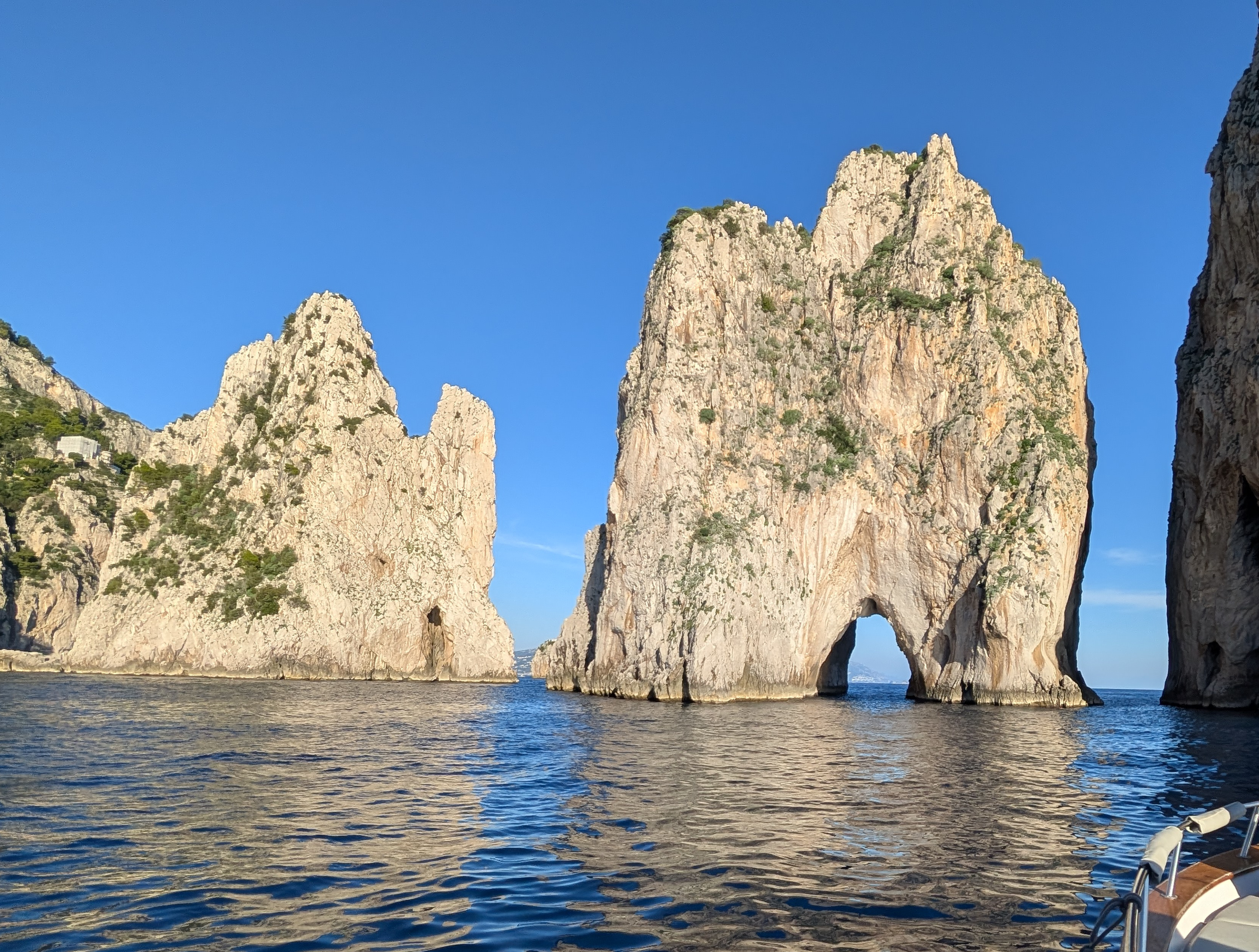
The boat operators took a nice picture of us as a memento.
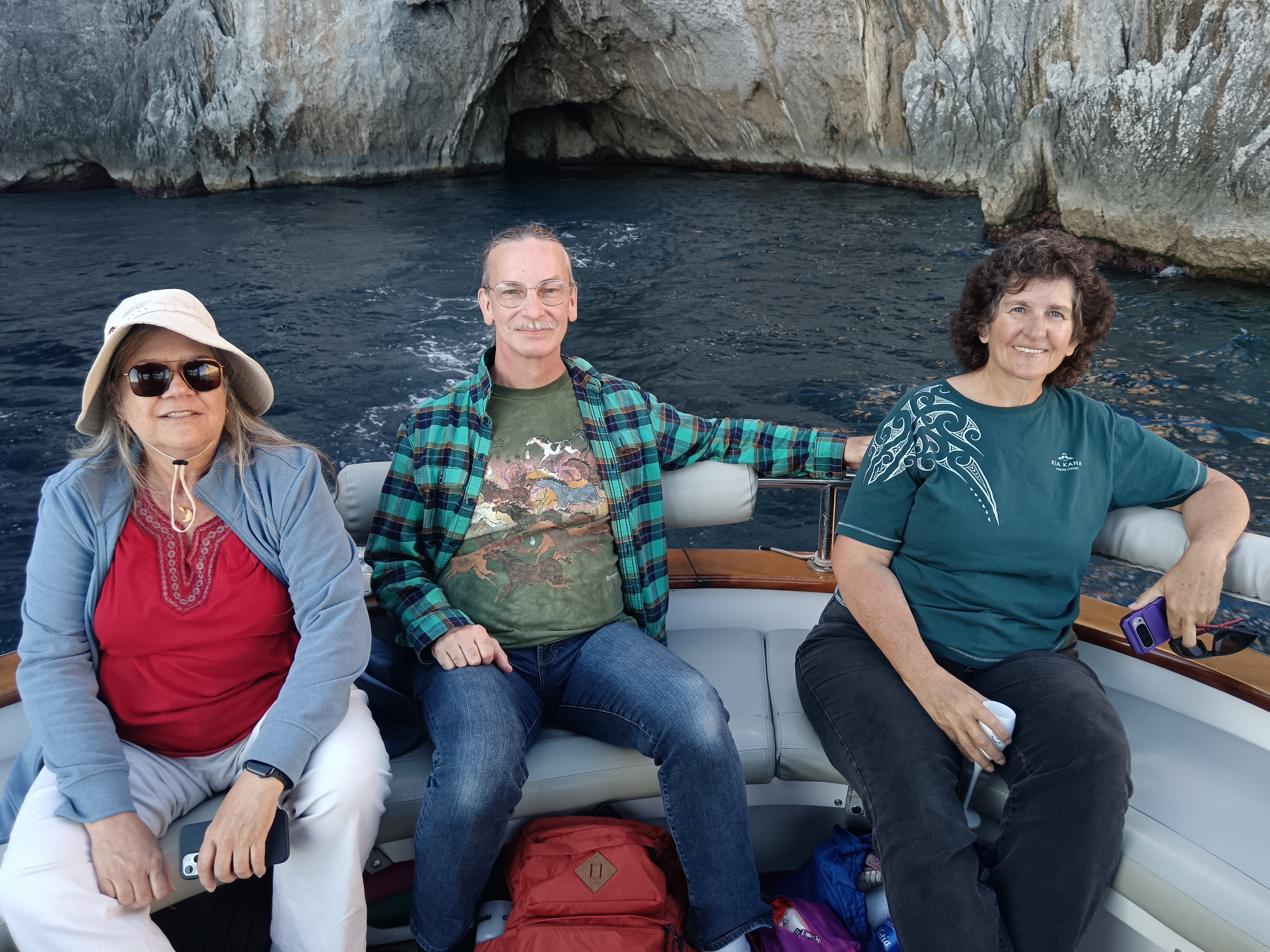
On Monday we took a bus tour down the Amalfi coast. We knew none of us wanted to try driving it ourselves. Because there wasn't much traffic, we made good time along the whole drive, so we could make a few more photo stops and spend a little more time in each of the small towns along the way. This is Positano, our first stop.

This is a typical view of the towns on the Amalfi coast from harbor level: every available space on the hillside is crammed with houses. We had seen a painting for sale a few days ago, which showed a skyline like this. Dave commented that the skyline really couldn't be that jagged ... but here is ocular proof.
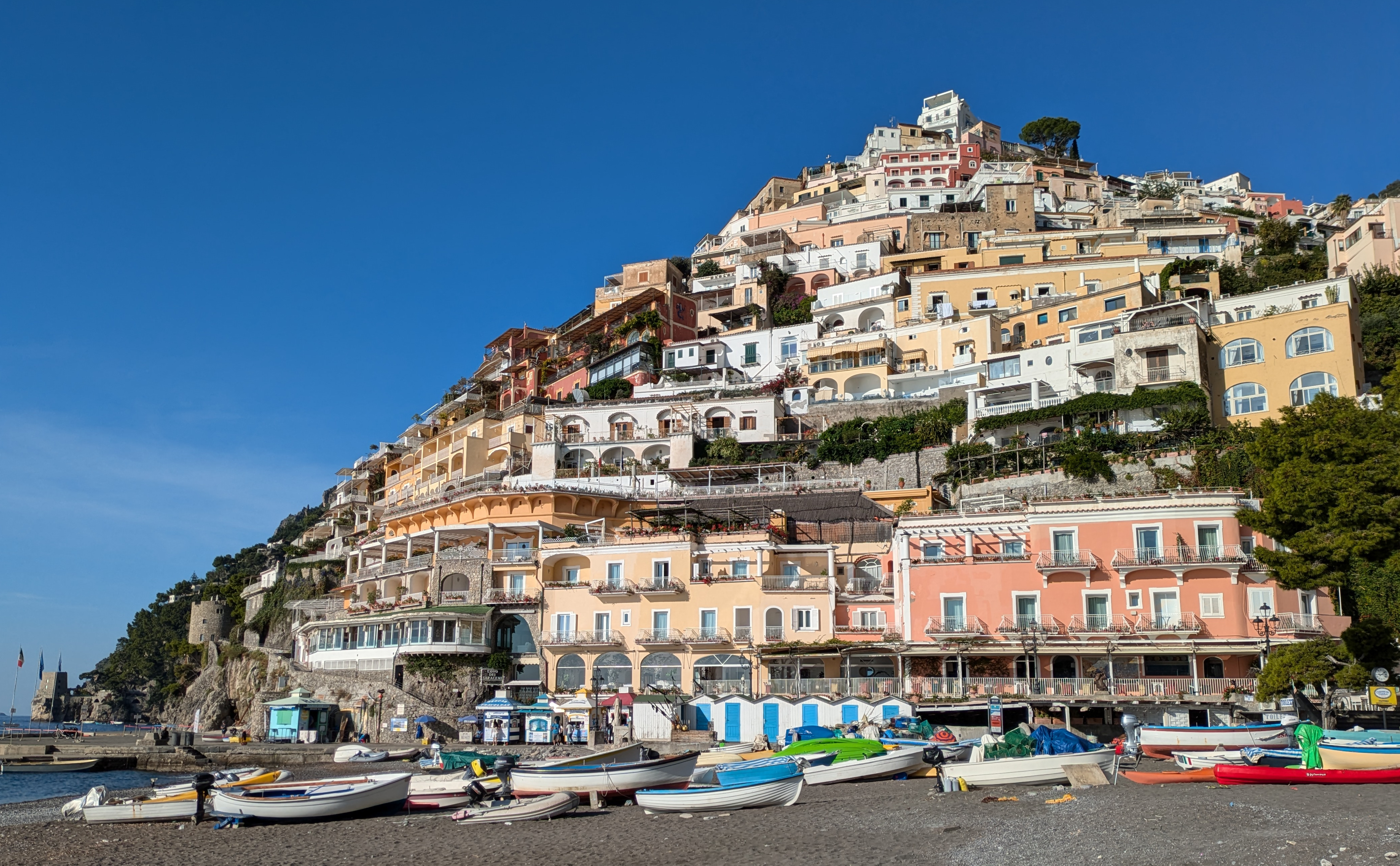
Looking the other way from the same harbor. An infinite line of beach umbrellas, waiting for next season when the tourists come back.
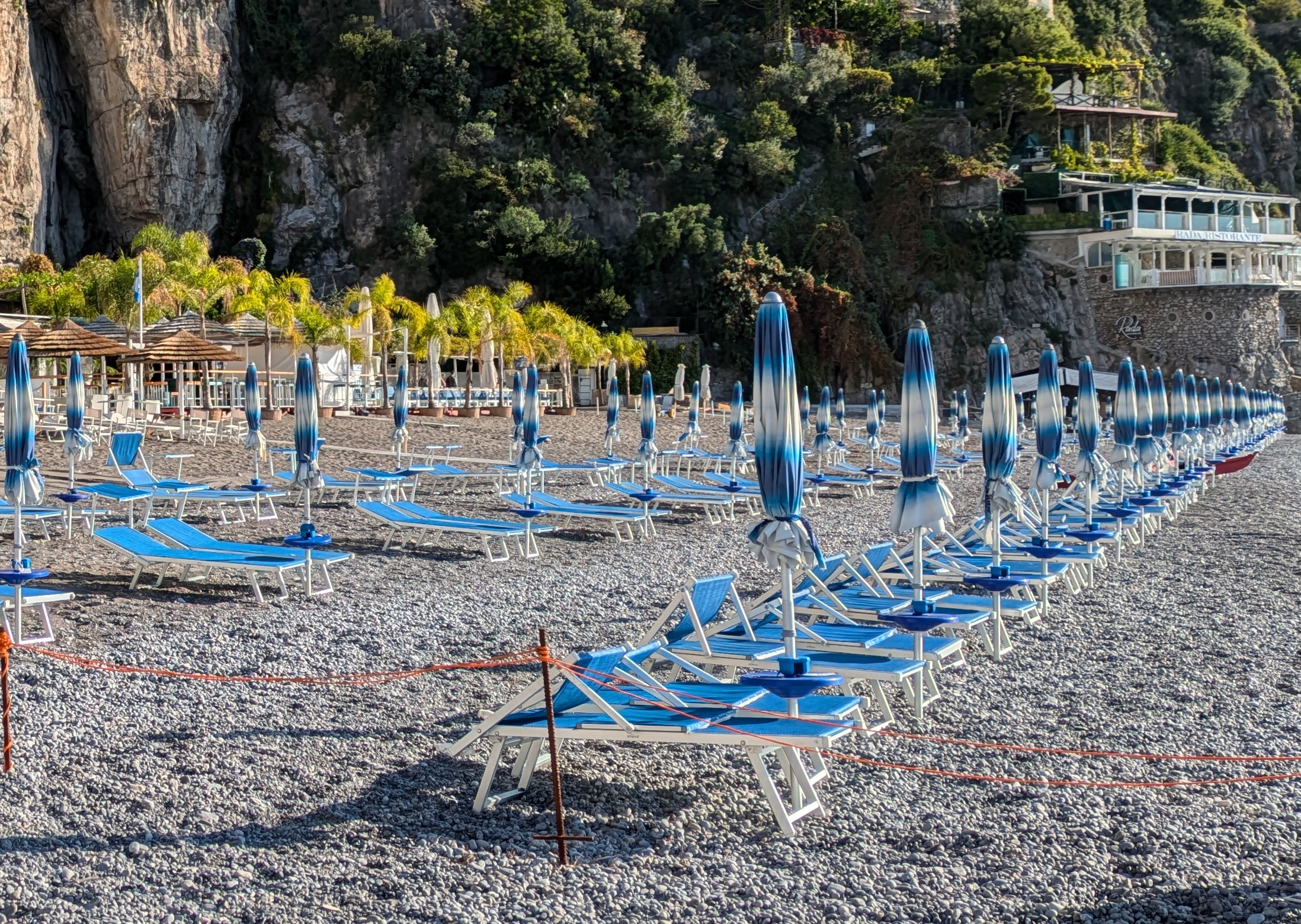
This ceramic wall piece seems a little ... psychotic?
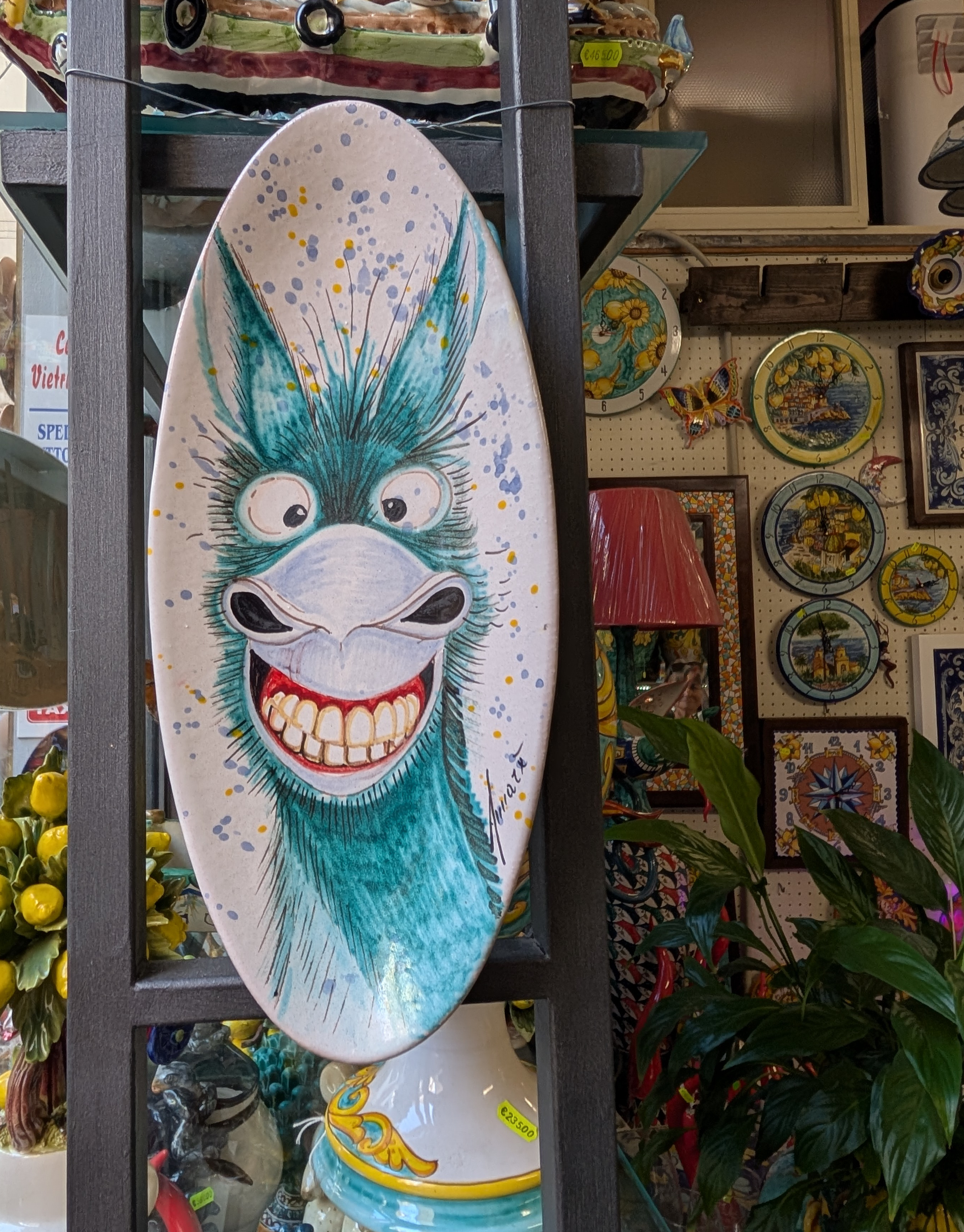
A rock outcropping along the coast.

The bus tour stopped in Amalfi for a couple of hours. The driver recommended that we take a boat tour to motor a little way up and back down the coast to see it from the ocean side. In our early planning we had thought we would take this trip using the ferries instead of a bus, but it turns out that the ferries only run during peak tourist season, and they had stopped just a few days before. The boat did provide a different view, mostly "up" instead of "down". The guide assured us that this is the best hotel on the Amalfi coast.
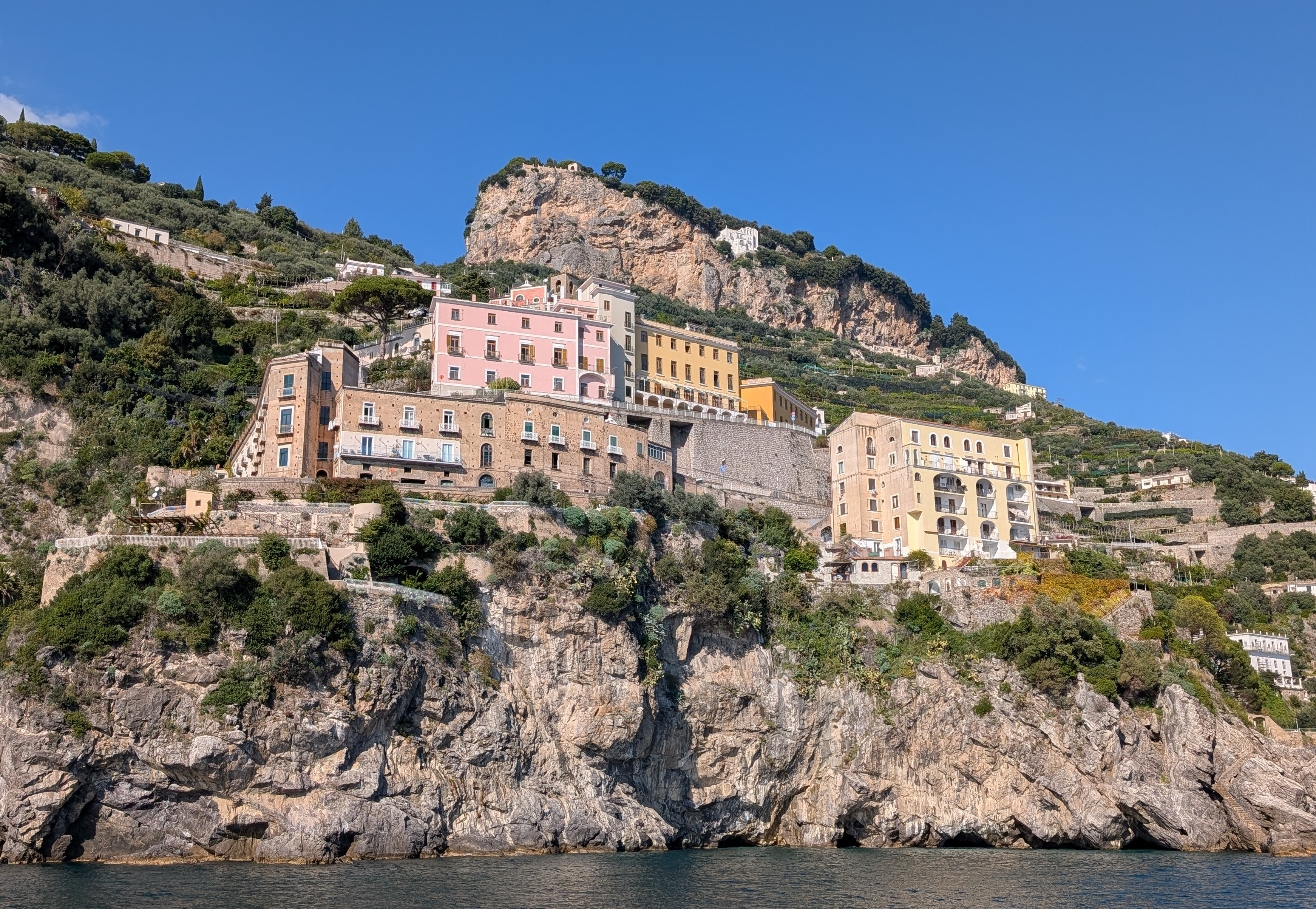
Our flight home was from Naples, at 6 am. So, the day before, we left Sorrento, took the one hour subway ride back to Naples, and checked into a final hotel for one night. Then we spent the day in Naples. We had hoped to go to the Archeological Museum, which we had seen in 2005. All of the original frescoes and artwork from Pompeii is on display there, and we had been really impressed. On site at Pompeii, they have recreations of the originals, since at the site, there is less protection against the elements (and against thieves). Sadly, the museum was closed that day due to a national holiday.
Instead, we took an "underground tour" which went through an aqueduct system preserved from Greek-Roman times. They were used during WWII as bomb shelters, and now they are a tourist attraction.

During the roman era, aristocrats could have a private well which reached directly to the aqueduct. The workers who maintained the aqueducts could climb up the well, and mischeviously move things around, or steal them. Since they wore white robes to protect themselves, this gave rise to a lot of ghost stories.
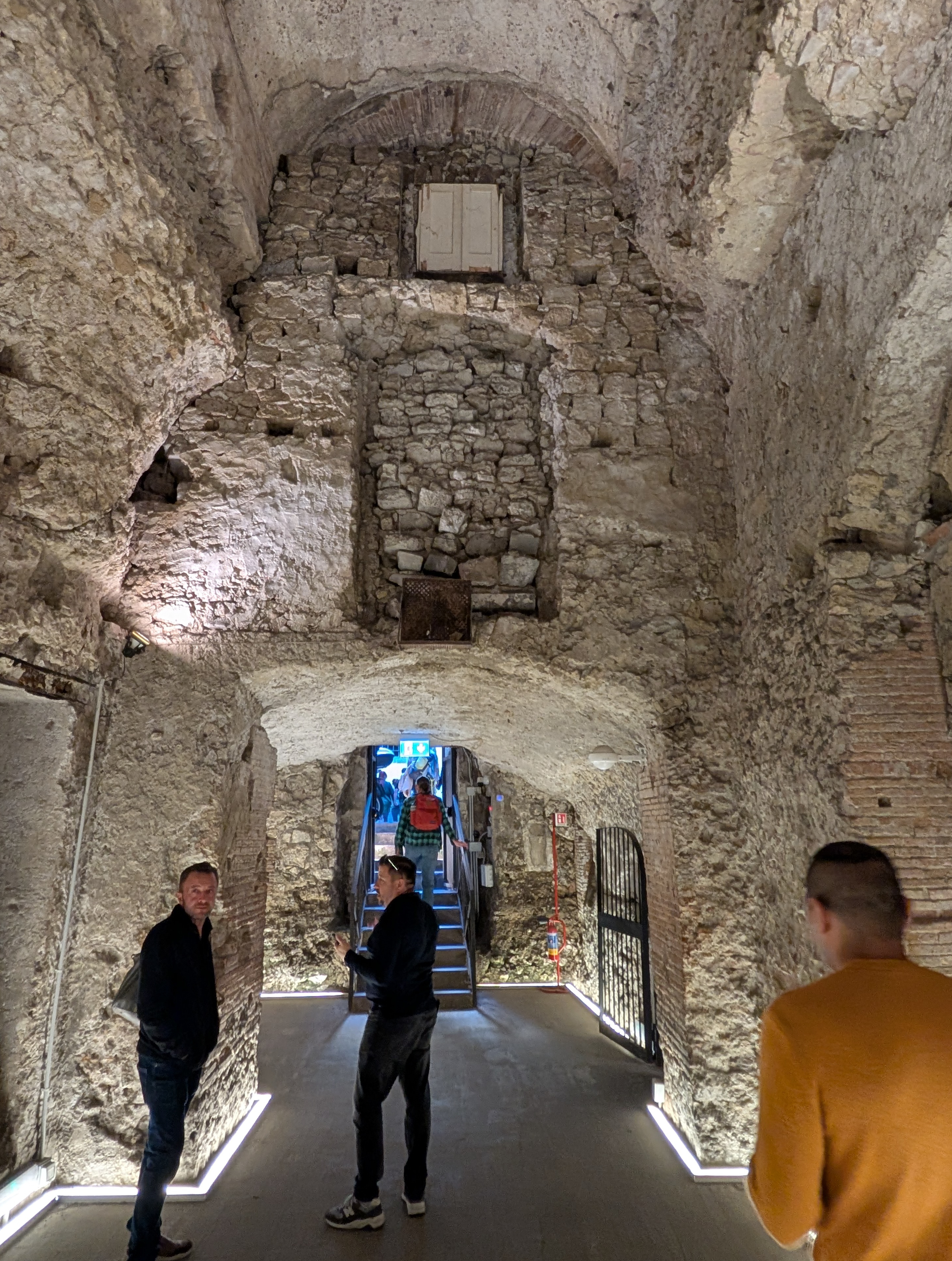
We didn't take a group picture this time. The group tour members were: